Application Of Derivatives Exercise – 6.1
Question 1. Find the rate of change of the area of a circle with respect to its radius r when
r = 3 cm
r = 4 cm
Solution:
The area of a circle (A) with radius (r) is given by, A =\(\pi r^2\)
Now, the rate of change of the area with respect to its radius is given by,
\(\frac{d \Lambda}{d r}=\frac{d}{d r}\left(\pi r^2\right)=2 \pi r\)
1. When r = 3 cm,\(\frac{\mathrm{dA}}{\mathrm{dr}}=2 \pi(3)\) = 6 \(\pi\)
Hence, the area of the circle is changing at the rate of 6\(\pi {cm}^2 /cm\) when its radius is 3 cm.
2. When r = 4cm,\(\frac{d A}{d r}=2 \pi(4)=8 \pi\)
Hence, the area of the circle is changing at the rate of 8\(\pi \mathrm{cm}^2 / \mathrm{cm}\) when its radius is 4 cm.
Question 2. The volume of a cube is increasing at the rate of 8 \({cm}^2\)s. How fast is the surface area increasing when the length of an edge is 12 cm?
Solution:
Let x be the length of the side, V be the volume and S be the surface area of the cube.
Then, V=\(x^3\) and S=\(6 x^2\)
It is given that \(\frac{\mathrm{dV}}{\mathrm{dt}}=8 \mathrm{~cm}^3 / \mathrm{s}\)
Then, by using the chain rule, we have:
8=\(\frac{d V}{d t}=\frac{d}{d t}\left(x^3\right)-3 x^2, \frac{d x}{d t} \Rightarrow \frac{d x}{d t}=\frac{8}{3 x^2}\)
Now; \(\frac{d S}{d t}=\frac{d}{d t}\left(6 x^2\right)=\frac{d}{d x}\left(6 x^2\right) \cdot \frac{d x}{d t}\) [By chain rule]
=12 x \(\cdot \frac{d x}{d t}=12 x \cdot\left(\frac{8}{3 x^2}\right)=\frac{32}{x}\) [From (1)]
Thus, when x=12\( \mathrm{~cm}, \frac{\mathrm{dS}}{\mathrm{dt}}=\frac{32}{12} \mathrm{~cm}^2 / \mathrm{s}=\frac{8}{3} \mathrm{~cm}^2 / \mathrm{s}\)
Hence, if the length of the edge of the cube is 12 cm, then the surface area is increasing at the rate of \(\frac{8}{3} \mathrm{~cm}^2 / \mathrm{s}\).
Read and Learn More Class 12 Maths Chapter Wise with Solutions
Question 3. The radius of a circle is increasing uniformly at the rate of 3 cm/s. Find the rate at which the area of the circle is increasing when the radius is 10 cm.
Solution:
The area of a circle (A) with radius (r) is given by, \(\mathrm{A}=\pi r^2\)
Now, the rate of change of area (A) with respect to time (t) is given by,
\(\frac{d \mathrm{~A}}{\mathrm{dt}}=\frac{\mathrm{d}}{\mathrm{dt}}\left(\pi r^2\right)=2 \pi r \frac{\mathrm{dr}}{\mathrm{dt}}\)
It is given that, \(\frac{\mathrm{dr}}{\mathrm{dt}}=3 \mathrm{~cm} / \mathrm{s}\)
⇒ \(\frac{d A}{d t}=2 \pi r(3)=6 \pi r\)
Thus, when \(\mathrm{r}=10 \mathrm{~cm}, \frac{\mathrm{dA}}{\mathrm{dt}}=6 \pi(10)=60 \pi \mathrm{cm}^2 / \mathrm{s}\)
Hence, the rate at which the area of the circle is increasing when the radius is 10 cm, is 60n \({~cm}^2/s\).
Question 4. An edge of a variable cube is increasing at the rate of 3 cm/s. How fast is the volume of the cube increasing when the edge is 10 cm long?
Solution:
Let x be the length of a side and V be the volume of the cube. Then, V = \(x^2\)
⇒ \(\frac{\mathrm{dV}}{\mathrm{dt}}=3 \mathrm{x}^2 \cdot \frac{\mathrm{dx}}{\mathrm{dt}}\)
It is given that, \(\frac{\mathrm{dx}}{\mathrm{dt}}=3 \mathrm{~cm} / \mathrm{s}\)
⇒ \(\frac{d V}{d t}=3 x^2(3)=9 x^2\)
Therefore, when x=10 \(\mathrm{~cm}, \frac{d V}{d t}=9(10)^2=900 \mathrm{~cm}^3 / \mathrm{s}\)
Hence, the volume of the cube is increasing at the rate of 900 \({~cm}^3\) when the edge is 10 cm long.
Question 5. A stone is dropped into a quiet lake and waves move in circles at the speed of 5 cm/s. At the instant when the radius of the circular wave is 8 cm, how fast is the enclosed area increasing?
Solution:
The area of a circle (A) with radius (r) is given by A = \(\pi r^2\).
Therefore, the rate of change of area (A) with respect to time (t) is given by,
⇒ \(\frac{\mathrm{d} A}{\mathrm{dt}}=\frac{\mathrm{d}}{\mathrm{dt}}\left(\pi \mathrm{r}^2\right)=\frac{\mathrm{d}}{\mathrm{dr}}\left(\pi \mathrm{r}^2\right) \frac{\mathrm{dr}}{\mathrm{dt}}\)
=2 \(\pi \mathrm{r} \frac{\mathrm{dr}}{\mathrm{dt}}\) [By chain rule]
It is given that \(\frac{\mathrm{dr}}{\mathrm{dt}}=5 \mathrm{~cm} / \mathrm{s}\)
Thus, when \(\mathrm{r}=8 \mathrm{~cm}, \frac{\mathrm{dA}}{\mathrm{dt}}=2 \pi(8)(5)=80 \pi\)
Hence, when the radius of the circular wave is 8 cm, the enclosed area is increasing at the rate of 80n \({~cm}^2\).
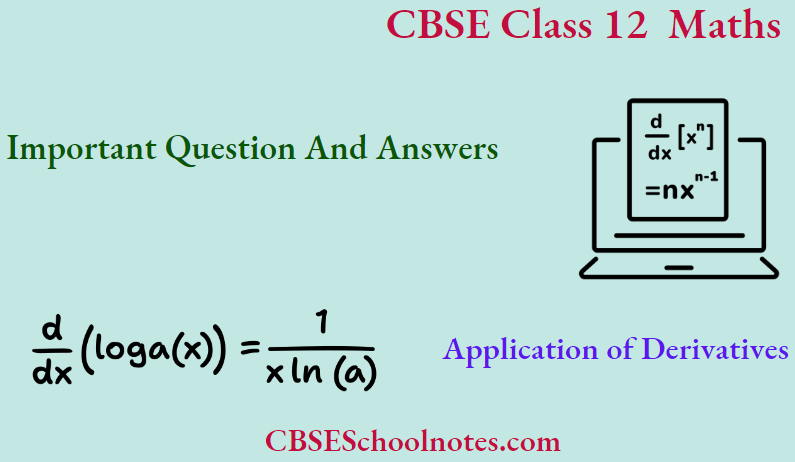
Question 6. The radius of a circle is increasing at the rate of 0.7 cm/s. What is the rate of increase of its circumference?
Solution:
The circumference of a circle (C) with radius ( r ) is given by \(\mathrm{C}-2 \pi \mathrm{r}\).
Therefore, the rate of change of circumference (C) with respect to time (t) is given by,
⇒ \(\frac{\mathrm{dC}}{\mathrm{dt}} =\frac{\mathrm{dC}}{\mathrm{dr}} \cdot \frac{\mathrm{dr}}{\mathrm{dt}}\)
⇒ \(=\frac{\mathrm{d}}{\mathrm{dr}}(2 \pi r) \frac{\mathrm{dr}}{\mathrm{dt}}=2 \pi \cdot \frac{\mathrm{dr}}{\mathrm{dt}}
\) [By chain rule]
It is given that \(\frac{\mathrm{dr}}{\mathrm{dt}}=0.7 \mathrm{~cm} / \mathrm{s}\)
Hence, the rate of increase of the circumference is \(2 \pi(0.7)=1.4 \pi \mathrm{cm} / \mathrm{s}\).
Question 7. The length x of a rectangle is decreasing at the rate of 5 cm/minute and the width y is increasing at the rate of 4 cm/minute. When x = 8 cm and y = 6 cm., find the rates of change of (a) the perimeter, and (b) the area of the rectangle..
Solution:
Since the length (x) is decreasing at the rate of 5 cm/minute and the width (y) is increasing at the rate of 4 cm/minute, we have:
⇒ \(\frac{\mathrm{dx}}{\mathrm{dt}}=-5 \mathrm{~cm} / \mathrm{min} \) and \(\frac{\mathrm{dy}}{\mathrm{dt}}=4 \mathrm{~cm} / \mathrm{min}
\)
1. The perimeter (P) of a rectangle is given by, P=2(x+y)
⇒ \(\frac{\mathrm{dP}}{\mathrm{dt}}=2\left(\frac{\mathrm{dx}}{\mathrm{dt}}+\frac{\mathrm{dy}}{\mathrm{dt}}\right)=2(-5+4)=-2 \mathrm{~cm} / \mathrm{min}\)
Hence, the perimeter is decreasing at the rate of \(2 \mathrm{~cm} / \mathrm{min}\).
2. The area (A) of a rectangle is given by, A=\(x \times y\)
⇒ \(\frac{d A}{d t}=\frac{d x}{d t} \cdot y+x \cdot \frac{d y}{d t}=-5 y+4 x\)
When x=8 cm and y=6 cm, \(\frac{\mathrm{dA}}{\mathrm{dt}}=(-5 \times 6+4 \times 8) \mathrm{cm}^2 / \mathrm{min}=2 \mathrm{~cm}^2 / \mathrm{min}\)
Hence, the area of the rectangle is increasing at the rate of 2 \({~cm}^2\)min.
Question 8. A balloon, which always remains spherical on inflation, is being inflated by pumping in 900 cubic centimeters of gas per second. Find the rate at which the radius of the balloon increases when the radius is 15 cm.
Solution:
The volume of a sphere (V) with radius (r) is given by, V =\(\frac{4}{3} \pi \mathrm{r}^3\)
The rate of change of volume (V) with respect to time (t) is given by,
⇒ \(\frac{d V}{d t} =\frac{d V}{d r} \cdot \frac{d r}{d t}\) [Chain rule]
=\(\frac{d}{d r}\left(\frac{4}{3} \pi r^3\right) \cdot \frac{d r}{d t}=4 \pi r^2 \cdot \frac{d r}{d t}\)
It is given that \(\frac{\mathrm{dV}}{\mathrm{dt}}=900 \mathrm{~cm}^3 / \mathrm{s}\)
900=4 \(\pi \mathrm{r}^2 \cdot \frac{\mathrm{dr}}{\mathrm{dt}} \Rightarrow \frac{\mathrm{dr}}{\mathrm{dt}}=\frac{900}{4 \pi \mathrm{r}^2}=\frac{225}{\pi \mathrm{r}^2}\)
Therefore, when radius -15 \(\mathrm{~cm}, \frac{\mathrm{dr}}{\mathrm{dt}}=\frac{225}{\pi(15)^2}=\frac{1}{\pi}\)
Hence, the rate at which the radius of the balloon increases, when the radius is 15 cm, is \(\frac{1}{\pi} \mathrm{cm} / \mathrm{s}\).
Question 9. A balloon, which always remains spherical has a variable radius. Find the rate at which its volume is increasing with the radius when the latter is 10 cm.
Solution:
The volume of a sphere (V) with radius (r) is given by \(\mathrm{V}=\frac{4}{3} \pi \mathrm{r}^3\).
The rate of change of volume (V) with respect to its radius (r) is given by,
⇒ \(\frac{d V}{d r}=\frac{d}{d r}\left(\frac{4}{3} \pi r^3\right)=\frac{4}{3} \pi\left(3 r^2\right)=4 \pi r^2\)
Therefore when radius =10 \(\mathrm{~cm}, \frac{d V}{d r}=4 \pi(10)^2=400 \pi\)
Hence, the volume of the balloon is increasing at the rate of 400 \(\pi \mathrm{cm}^7 / \mathrm{cm}\).
Question 10. A ladder 5 m long is leaning against a wall. The bottom of the ladder is pulled along the ground, away from the wall, at the rate of 2 cm/s. How fast is its height on the wall decreasing when the foot of the ladder is 4 m away from the wall?
Solution:
Let y m be the height of the wall at which the ladder touches. Also, let the foot of the ladder be x m away from the wall.
Then, by Pythagoras theorem, we have: \(x^2+y^2\)=25 [Length of the ladder =5m]
y=\(\sqrt{25-x^2}\)
Then, the rate of change of height (y) with respect to time (t) is given by \(\frac{d y}{d t}=\frac{-x}{\sqrt{25-x^2}} \cdot \frac{d x}{d t}\)
It is given that \(\frac{d x}{d t}=0.02 \mathrm{~m} / \mathrm{s} \frac{d y}{d t}=\frac{-x}{\sqrt{25-x^2}} \times \frac{2}{100} \mathrm{~m} / \mathrm{s}\)
Now when x=4 \(\mathrm{~m}, we have: \frac{d y}{d t}=\frac{-4 \times 2}{100 \times 3} \mathrm{~m} / \mathrm{s}\)
=-\(\frac{8}{300} \mathrm{~m} / \mathrm{s}=-\frac{8}{3} \mathrm{~cm} / \mathrm{s}\)
Hence, the height of the ladder on the wall is decreasing at the rate of \(\frac{8}{3} \mathrm{~cm} / \mathrm{s}\),
Question 11. A particle moves along the curve \(6 y=x^3+2\). Find the points on the curve at which the y-coordinate is changing 8 times as fast as the x-coordinate.
Solution:
The equation of the curve is given as:
6 y=\(x^3+2\)
The rate of change of the position of the particle with respect to time (t) is given by
6 \(\frac{d y}{d t}=3 x^2 \frac{d x}{d t}+0 \Rightarrow 2 \frac{d y}{d t}=x^2 \frac{d x}{d t}\)
When the y-coordinate of the particle changes 8 times as fast as the x-coordinate i.e., \(\left(\frac{\mathrm{dy}}{\mathrm{dt}}=8 \frac{\mathrm{dx}}{\mathrm{dt}}\right)\), we have:
2\(\left(8 \frac{d x}{d t}\right)=x^2 \frac{d x}{d t} \Rightarrow 16 \frac{d x}{d t}=x^2 \frac{d x}{d t}\)
⇒ \(\left(x^2-16\right) \frac{d x}{d t}=0 \Rightarrow x^2=16 \Rightarrow x= \pm 4\)
When x=4, y=\(\frac{4^3+2}{6}=\frac{66}{6}=11\)
When x=-4, y=\(\frac{(-4)^3+2}{6}=-\frac{62}{6}=-\frac{31}{3}\)
Hence, the points on the curve are (4,11) and \(\left(-4, \frac{-31}{3}\right)\)
Question 12. The radius of an air bubble is increasing at the rate of \(\frac{1}{2} \mathrm{~cm} / \mathrm{s}\). At what rate is the volume of the bubble increasing when the radius is 1 cm ?
Solution:
The air bubble is in the shape of a sphere.
Now, the volume of an air bubble (V) with radius ( r ) is given by, V=\(\frac{4}{3} \pi r^3\)
The rate of change of volume (V) with respect to time (t) is given by,
⇒ \(\frac{\mathrm{dV}}{\mathrm{dt}} =\frac{4}{3} \pi \frac{\mathrm{d}}{\mathrm{dr}}\left(\mathrm{r}^3\right) \cdot \frac{\mathrm{dr}}{\mathrm{dt}}\)
=\(\frac{4}{3} \pi\left(3 \mathrm{r}^2\right) \frac{\mathrm{dr}}{\mathrm{dt}}-4 \pi \mathrm{r}^2 \frac{\mathrm{dr}}{\mathrm{dt}}\) [By chain rule]
It is given that \(\frac{\mathrm{dr}}{\mathrm{dt}}=\frac{1}{2} \mathrm{~cm} / \mathrm{s}\)
Therefore, when \(\mathrm{r}=1 \mathrm{~cm}, \frac{\mathrm{dV}}{\mathrm{dt}}=4 \pi(1)^2\left(\frac{1}{2}\right)=2 \pi \mathrm{cm}^3 / \mathrm{s}\)
Hence, the rate at which the volume of the bubble increases is 2 \(\pi \mathrm{cm}^3 / \mathrm{s}\).
Question 13. A balloon, which always remains spherical, has a variable diameter \(\frac{3}{2}(2 x+1)\). Find the rate of change of its volume with respect to x.
Solution:
The volume of a sphere (V) with radius (r) is given by, V = \(\frac{4}{3} \pi r^3\)
It is given that:
Diameter =\(\frac{3}{2}(2 x+1) \Rightarrow r=\frac{3}{4}(2 x+1)\)
V=\(\frac{4}{3} \pi\left(\frac{3}{4}\right)^3(2 x+1)^3=\frac{9}{16} \pi(2 x+1)^3\)
Hence, the rate of change of volume with respect to x is:
⇒ \(\frac{\mathrm{dV}}{\mathrm{dx}}=\frac{9}{16} \pi \frac{\mathrm{d}}{\mathrm{dx}}(2 \mathrm{x}+1)^3\)
= \(\frac{9}{16} \pi \times 3(2 \mathrm{x}+1)^2 \cdot \times 2=\frac{27}{8} \pi(2 \mathrm{x}+1)^2\)
Question 14. Sand is poured from a pipe at the rate of 12 cm. The falling sand forms a cone on the ground in such a way that the height of the cone is always one-sixth of the radius of the base. How fast is the height of the sand cone increasing when the height is 4 cm?
Solution:
The volume of a cone (V) with radius (r) and height (h) is given by, \(\mathrm{V}=\frac{1}{3} \pi r^2 \mathrm{~h}\)
It is given that, h=\(\frac{1}{6} r \Rightarrow r=6 h\)
V=\(\frac{1}{3} \pi(6 h)^7 h=12 \pi h^3\)
The rate of change of volume with respect to time (t) is given by,
⇒ \(\frac{d V}{d t}=12 \pi \frac{d}{d h}\left(h^2\right) \cdot \frac{d h}{d t}\)
=12 \(\pi\left(3 h^2\right) \frac{d h}{d t}=36 \pi h^2 \frac{d h}{d t}\) [By Chain rule]
It is also given that \(\frac{d V}{d t}=12 \mathrm{~cm}^3 / \mathrm{s}\)
Therefore, when h = 4 cm, we have:
12=36 \(\pi(4)^2 \frac{\mathrm{dh}}{\mathrm{dt}}\)
⇒ \(\frac{\mathrm{dh}}{\mathrm{dt}}=\frac{12}{36 \pi(16)}=\frac{1}{48 \pi}\)
Hence, when the height of the sand cone is 4 cm, its height is increasing at the rate of \(\frac{1}{48 \pi} \mathrm{cm} / \mathrm{s}\).
Question 15. The total cost C (x) in Rupees associated with the production of x units of an item is given by C(x)=\(0.007 x^3-0.003 x^2+15\) x+4000. Find the marginal cost when 17 units are produced.
Solution:
Marginal cost is the rate of change of total cost with respect to output.
Marginal cost (M C) = \(\frac{d C}{d x}=0.007\left(3 x^2\right)\)-0.003(2 x)+15=0.021 x^2-0.006 x+15
When x = 17, MC =0.021\(\left(17^3\right)\)-0,006(17)+15
= 0.021(289) – 0.006(17) + 15 – 6.069 – 0.102 + 15 – 20.967
Hence, when 17 units are produced, the marginal cost is Rs, 20.967.
Question 16. The total revenue in Rupees received from the sale of x units of a product is given by R(x) = \(13 x^1+26 x+15\). Find the marginal revenue when x = 7.
Solution:
Marginal revenue is the rate of change of total revenue with respect to the number of units sold.
Marginal Revenue(M R)=\(\frac{d R}{d x}\)=13(2 x)+26=26 x+26
When x = 7, MR = 26(7) + 26 = 182 + 26 = 208.
Hence, the required marginal revenue is Rs 208.
Question 17. The rate of change of the area of a circle with respect to its radius r at r = 6 cm is?
- 10 \(\pi\)
- 12 \(\pi\)
- 8 \(\pi\)
- 11 \(\pi\)
Solution: 2. 12 \(\pi\)
The area of a circle (A) with radius (r) is given by, A=\(\pi \mathrm{r}^2\)
Therefore, the rate of change of the area with respect to its radius r is \(\frac{\mathrm{dA}}{\mathrm{dr}}=\frac{\mathrm{d}}{\mathrm{dr}}\left(\pi \mathrm{r}^2\right)=2 \pi r\).
When \(\mathrm{r}=6 \mathrm{~cm}, \frac{\mathrm{dA}}{\mathrm{dr}}=2 \pi \times 6=12 \pi \mathrm{cm}^2 / \mathrm{cm}\)
Hence, the required rate of change of the area of a circle is 12 \(\pi \mathrm{cm}^2 cm\)
The correct answer is 2.
Question 18. The total revenue in Rupees received from the sale of x units of a product is given by R(x) = \(3 x^2+36 x+5\). The marginal revenue, when x = 15, is?
- 116
- 96
- 90
- 126
Solution: 4. 126
Marginal revenue is the rate of change of total revenue with respect to the number of units sold.
Marginal Revenue (MR) = \(\frac{\mathrm{dR}}{\mathrm{dx}}=3(2 \mathrm{x})+36=6 x +36\)
When x = 15, MR = 6(15) + 36 = 90 + 36 = 126
Hence, the required marginal revenue is Rs 126.
The correct answer is 4.
Applications Of Derivatives Exercise 6.2
Question 1. Show that the function given by f(x)=3 x+17 is strictly increasing on R.
Solution:
Let \(x_2, x_2 \in\) R, such that \(x_1<x_1 \Rightarrow 3 x_1<3 x_1 \Rightarrow 3 x_1+17<3 x_2+17 \Rightarrow f\left(x_1\right)<f\left(x_2\right)\)
Hence, f is strictly increasing on R.
Alternate method:
Given \(f^{\prime}(x)=3 x+17\). On diff. w.r.t. x, we get \(f^{\prime}(x)=3>0\), in every interval of R.
Thus, the function is strictly increasing on R.
Question 2. Show that the function given by $f(x)=e^{2 n}$ is strictly increasing on R.
Solution:
Let \(x_1, x_2 \in\) R, such that \(x_1<x_1\)
⇒ \(2 x_1<2 x_1 \Rightarrow e^{2 x_1}<e^{2 x_1}\)
f\(\left(x_1\right)<f\left(x_2\right)\)
Hence, f is strictly increasing on R.
Question 3. Show that the function given by f(x)=\(\sin x\) is
- strictly increasing in \(\left(0, \frac{\pi}{2}\right)\)
- strictly decreasing in \(\left(\frac{\pi}{2}, \pi\right)\)
- neither increasing nor decreasing in (0, \(\pi\))
Solution:
The given function is f(x)-\(\sin x\).
⇒ \(f^{\prime}(x)=\cos \mathrm{x}\)
1. Since for each x \(\in\left(0, \frac{\pi}{2}\right), \cos x>0\) we have \(f^{\prime}(x)>0\),
Hence, f is strictly increasing in \(\left(0, \frac{\pi}{2}\right)\).
2. Since for each x \(\in\left(\frac{\pi}{2}, \pi\right), \cos x<0\), we have \(f^{\prime \prime}(x)<0\).
Hence, f is strictly decreasing in \(\left(\frac{\pi}{2}, \pi\right)\)
3. From the results obtained in (1) and (2) it is clear that f is strictly increasing in \(\left(0, \frac{\pi}{2}\right)[\) and strictly decreasing in \(\left(\frac{\pi}{2}, \pi\right)\)
So, f is neither increasing nor decreasing in (0, \(\pi\)).
Question 4. Find the intervals in which the function f given by f(x)=2 \(x^2-3\) x is
- strictly increasing
- strictly decreasing
Solution:
The given function is f(x)=2 \(x^2-3 x, f^{\prime}(x)\)=4 x-3
Putting f(x)=0 \(\Rightarrow 4 x-3=0 \Rightarrow x=\frac{3}{4}\)
Now, the point \(\frac{3}{4}\) divides the real line into two disjoint intervals i.e. \(\left(-\infty, \frac{3}{4}\right) and \left(\frac{3}{4}, \infty\right)\)

In interval \(\left(-\infty, \frac{3}{4}\right), \mathrm{f}^{\prime}(\mathrm{x})<0\)
Hence, the given function (f) is strictly decreasing in the interval \(\left(-\infty, \frac{3}{4}\right)\).
In interval \(\left(\frac{3}{4}, \infty\right), \mathrm{f}^{\prime}(\mathrm{x})>0\)
Hence, the given function (f) is strictly increasing in the interval \(\left(\frac{3}{4}, \infty\right)\).
Question 5. Find the intervals in which the function f given by f(x)=2 \(x^3-3 x^2-36 x+7\) is
- Strictly increasing
- Strictly decreasing
Solution:
The given function is f(x)=\(2 x^3-3 x^2-36 x+7\).
⇒ \(f(x)=6 x^2-6 x-36=6\left(x^2-x-6\right)=6(x+2)(x-3)\)
⇒ \(\mathrm{f}(\mathrm{x})=0 \Rightarrow \mathrm{x}=-2,3\)
The points x=-2 and x =3 divide the real line into three disjoint intervals i.e, \((-\infty,-2),(-2,3) and (3, \infty)\)
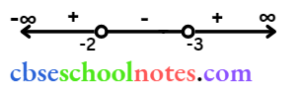
In intervals \((-\infty,-2) and (3, \infty), f^{\prime}(x)\) is positive while in interval \((-2,3), f^{\prime}(x)\) is negative.
Hence, the given function f(x) is strictiy increasing in intervals \((-\infty,-2) \cup(3, \infty)\), while function f(x) is strictly decreasing in interval (-2,3).
Question 6. Find the intervals in which the following functions are strictly increasing or decreasing:
- \(x^2+2 x-5\)
- 10-6 \(\mathrm{x}-2 \mathrm{x}^2\)
- \(-2 x^3-9 x^2-12 x+1\)
- \(6-9 x-x^2\)
Solution 1. \(x^2+2 x-5\)
⇒ \((x+1)^3(x-3)^2\)
1. We have, \(f(x)=x^7+2 x-5\)
⇒ \(f^{\prime}(x)=2 x+2\)
Now, \(\mathrm{f}^{\prime}(\mathrm{x})=0 \Rightarrow \mathrm{x}=-1\)
Point x=-1 divides the real line into two disjoint intervals i.e., \((-\infty,-1) and (-1, \infty)\)
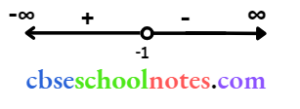
In interval \((-\infty,-1), f^{\prime}(x)<0\).
f is strictly decreasing in the interval (-\infty,-1)
Thus, f is strictly decreasing for x<-1.
In interval (-1, \(\infty), f^{\prime}(x)>0\)
f is strictly increasing in interval \((-1, \infty)\)
Thus, f is strictly increasing for x>-1
2. We have, f(x)=\(10-6 x-2 x^3\)
\(f^{\prime}(x)=-6-4 x\)Now, \(\mathrm{r}^{\prime}(\mathrm{x})=0 \Rightarrow \mathrm{x}=-\frac{3}{2}\)
The point x=-\(\frac{3}{2}\) divides the real line into two disjoint intervals i.e., \(\left(-\infty,-\frac{3}{2}\right) and \left(-\frac{3}{2}, \infty\right)\)

In interval \(\left(-\infty,-\frac{3}{2}\right)\) i.e., when \(x<-\frac{3}{2}, f^{\prime}(x)>0\).
f is strictly increasing for \(\mathrm{x}<-\frac{3}{2}\).
In interval \(\left(-\frac{3}{2}, \infty\right)\) i.e., when \(x>-\frac{3}{2}, f^{\prime}(x)<0\).
f is strictly decreasing for \(x>-\frac{3}{2}\)
3. We have, f(x)=\(-2 x^3-9 x^2-12 x+1\)
f(x)=\(-6 x^2-18 x-12=-6\left(x^2+3 x+2\right)=-6(x+1)(x+2)\)
Now; \(f^{\prime}(x)=0 \Rightarrow x=-1\) and x=-2
Points x=-1 and x=-2 divide the real line into three disjoint intervals
i.e., \((-\infty,-2),(-2,-1)\) and (-1, \(\infty)\)
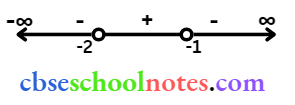
In intervals \((-\infty,-2) and (-1, \infty)\) i.e., when x<-2 and \(x>-1, f^{\prime}(x)<0\)
f is strictly decreasing for x<-2 \(\cup x>-1.\)
Now, in interval (-2,-1) i.e., when \(-2<x<-1, f^{\prime}(x)>0.\)
f is strietly increasing for \(-2<\mathrm{x}<-1\).
4. We have, f(x)=\(6-9 x-x^2\)
⇒ \(f^{\prime}(x)\)=-9-2 x
Now, \(f^{\prime}(x)\)=0 gives x=-\(\frac{9}{2}\)
The point x =\(-\frac{9}{2}\) divides the real line into two disjoint intervals ie. \(\left(-\infty,-\frac{9}{2}\right)\) and \(\left(-\frac{9}{2}, \infty\right)\)
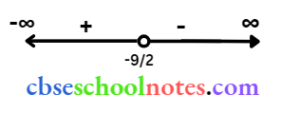
In interval \(\left(-\infty,-\frac{9}{2}\right)\) i.e., for \(x<-\frac{9}{2}, f^{\prime}(x)>0\).
f is strictly increasing for \(\mathrm{x}<-\frac{9}{2}\)
In interval \(\left(-\frac{9}{2}, \infty\right)\) i.e., for \(x>-\frac{9}{2}, f^{\prime}(x)<0\).
f is strictly decreasing for \(\mathrm{x}>-\frac{9}{2}\).
5. We have, f(x)=\((x+1)^3(x-3)^5\)
⇒ \(f^{\prime}(x) =3(x+1)^2(x-3)^3+3(x-3)^2(x+1)^3=3(x+1)^2(x-3)^2[x-3+x+1]\)
=\(3(x+1)^2(x-3)^2(2 x-2)=6(x+1)^4(x-3)^2(x-1)\)
Now, \(f^{\prime}(x)=0 \Rightarrow x=-i, 3, i\)
The points x=-1, x 1, and x=3 divide the real line into four disjoint intervals i.e., \((-\infty,-1),(-1,1),(1,3)\) and \((3, \infty\)).
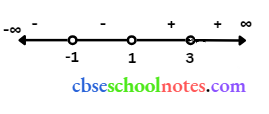
In intervals \((-\infty,-1)\) and \((-1,1), \mathrm{f}^{\prime}(\mathrm{x})<0\).
f is strictly decreasing in intervals \((-\infty,-1) \cup(-1,1)\).
In intervals (1,3) and (3, \(\infty), f^{\prime}(x)>0\).
f is strictly increasing in intervals (1,3) \(\cup(3, \infty)\)
Question 7. Show that y=\(\log (1+x)-\frac{2 x}{2+x}\), x>-1, is an increasing function of x throughout its domain.
Solution:
We have, y=\(\log (1+x)-\frac{2 x}{2+x}\)
⇒ \(\frac{d y}{d x}=\frac{1}{1+x}-\frac{(2+x)(2)-2 x(1)}{(2+x)^2}=\frac{1}{1+x}-\frac{4}{(2+x)^2}=\frac{x^2}{(1+x)(2+x)^2}\)
When x \(\in(-1, \infty), then \frac{x^2}{(2+x)^2}>0\) and (1+x)>0
⇒ \(\frac{d y}{d x}>0\) when x>-1.
y is an increasing function of x throughout its domain, i.e. (x>-1)
Question 8. Find the values of x for which y=\([x(x-2)]^2\) is an increasing function.
Solution:
We have, y=\([x(x-2)]^2-\left[x^2-2 x\right]^1\)
⇒ \(\frac{d y}{d x}=2\left(x^2-2 x\right)(2 x-2)=4 x(x-2)(x-1)\)
⇒ \(\frac{d y}{d x}=0 \Rightarrow\) x=0, x=2, x=1
The points x =0, x =1, and x=2 divide the real line into four disjoint intervals i.e., \((-\infty, 0), [0,1][1,2]\) and \([2, \infty)\)

In intervals \((-\infty, 0]\) and \([1,2], \frac{\mathrm{dy}}{\mathrm{dx}} \leq 0\)
y is decreasing in intervals \((-\infty, 0] \cup[1,2]\).
However, in intervals [0,1] and [2, x), \(\frac{d y}{d x} \geq 0\)
y is increasing in intervals [0,1] \(\cup[2, \infty)\).
Question 9. Prove that y=\(\frac{4 \sin \theta}{(2+\cos \theta)}-\theta\) is an increasing function of \(\theta\) in \(\left[0, \frac{\pi}{2}\right]\).
Solution:
We have, y=\(\frac{4 \sin \theta}{(2+\cos \theta)}-\theta\)
⇒ \(\frac{d y}{d \theta} =\frac{(2+\cos \theta)(4 \cos \theta)-4 \sin \theta(-\sin \theta)}{(2+\cos \theta)^2}-1\)
=\(\frac{8 \cos \theta+4 \cos ^2 \theta+4 \sin ^2 \theta}{(2+\cos \theta)^2}-1=\frac{8 \cos \theta+4}{(2+\cos \theta)^2}-1\)
⇒ \(\frac{d y}{d \theta}=\frac{8 \cos \theta+4-\left(4+\cos ^2 \theta+4 \cos \theta\right)}{(2+\cos \theta)^2}-\frac{4 \cos \theta-\cos ^2 \theta}{(2+\cos \theta)^2}\)
=\(\frac{\cos \theta(4-\cos \theta)}{(2+\cos \theta)^2}\)
In interval \(\left[0, \frac{\pi}{2}\right]\), we have \(\cos \theta \geq 0\). Also, \(4>\cos \theta \Rightarrow 4-\cos \theta>0\)
⇒ \(\cos \theta(4-\cos \theta)>0\) and also \((2+\cos \theta)^2>0\)
⇒ \(\frac{\cos \theta(4-\cos \theta)}{(2+\cos \theta)^2} \geq 0 \Rightarrow \frac{d y}{d x} \geq 0\)
Therefore, y is increasing in the interval \(\left[0, \frac{\pi}{2}\right]\).
Question 10. Prove that the logarithmic function is strictly increasing on (0, \(\infty)\).
Solution:
Let f(x)=\(\log x\).
⇒ \(\mathrm{f}^{\prime}(\mathrm{x})=\frac{1}{\mathrm{x}}\)
It is clear that for x>0, \(f^{\prime}(x)=\frac{1}{x}>0\)
Hence, f(x)= log x is strictly increasing in the interval \((0, \infty)\).
Question 11. Prove that the function f given by f(x)=\(x^2-x+1\) is neither strictly increasing nor strictly decreasing on (-1,1).
Solution:
The given function is f(x)=\(x^2-x+1\).
⇒ \(f^{\prime}(x)=2 x-1\)
Now, \(f^{\prime}(x)=\theta \Rightarrow x=\frac{1}{2}\)
The point \(\frac{1}{2}\) divides the interval (-1,1) into two disjoint intervals i.e., \(\left(-1, \frac{1}{2}\right) and \left(\frac{1}{2}, 1\right)\)

Now, in interval \(\left(-1, \frac{1}{2}\right), \mathrm{f}^{\prime}(\mathrm{x})=2 \mathrm{x}-1<0\)
Therefore, f is strictly decreasing in the interval \(\left(-1, \frac{1}{2}\right)\).
However, in interval \(\left(\frac{1}{2}, 1\right), f^{\prime}(x)=2 x-1>0\)
Therefore, f is strictly increasing in the interval \(\left(\frac{1}{2}, 1\right)\).
Hence, f is neither strictly increasing nor strictly decreasing in interval (-1,1).
Question 12. Which of the following functions are strictly decreasing on \(\left(0, \frac{\pi}{2}\right)\)?
- \(\cos x\)
- \(\cos 2 x\)
- \(\cos 3 x\)
- \(\tan x\)
Solution:
1. Let \(f_2(x)=\cos x\)
⇒ \(f_1^{\prime}(x)=-\sin x\)
In interval \(\left(0, \frac{\pi}{2}\right), f_1^{\prime}(x)=-\sin x<0\)
⇒ \(\mathrm{f}_1(\mathrm{x})\) is strictly decreasing in interval \(\left(0, \frac{\pi}{2}\right)\).
2. Let \(f_2(x)=\cos 2 x\)
⇒ \(f_2(x)=-2 \sin 2 x\)
Now, \(0<x<\frac{\pi}{2} \Rightarrow 0<2 x<\pi \Rightarrow \sin 2 x>0 \Rightarrow-2 \sin 2 x<0\)
⇒ \(\mathrm{f}_2^{\prime}(\mathrm{x})=-2 \sin 2 \mathrm{x}<0 on \left(0, \frac{\pi}{2}\right)\)
⇒ \(\mathrm{f}_2(\mathrm{x})\) is strictly decreasing in interval \(\left(0, \frac{\pi}{2}\right)\).
3. Let \(f_1(x)=\cos 3 x\).
⇒ \(f_5^{\prime}(x)=-3 \sin 3 x\)
Now, \(f^{\prime}(x)=0\)
⇒ \(\sin 3 x=0 \Rightarrow 3 x=\pi, as x \in\left(0, \frac{\pi}{2}\right) \Rightarrow x=\frac{\pi}{3}\)
The point \(\mathrm{x}=\frac{\pi}{3}\) divides the interval \(\left(0, \frac{\pi}{2}\right)\) into two disjoint intervals i.e., \(\left(0, \frac{\pi}{3}\right)\) and \(\left(\frac{\pi}{3}, \frac{\pi}{2}\right)\)
Now in interval \(\left(0, \frac{\pi}{3}\right), f_3^{\prime}(x)=-3 \sin 3 x<0\) \(\left[\right. as \left.0<x<\frac{\pi}{3} \Rightarrow 0<3 x<\pi\right]\)
⇒ \(\mathrm{f}(\mathrm{x})\) is strictly decreasing in interval \(\left(0, \frac{\pi}{3}\right)\)
However, in interval \(\left(\frac{\pi}{3}, \frac{\pi}{2}\right), \mathrm{f}^{\prime}(\mathrm{x})\)
=\(-3 \sin 3 \mathrm{x}>0 \left[\right.as\left.\frac{\pi}{3}<\mathrm{x}<\frac{\pi}{2} \Rightarrow \pi<3 \mathrm{x}<\frac{3 \pi}{2}\right]\)
⇒ \(\mathrm{f}_3(\mathrm{x})\) is strictly increasing in interval \(\left(\frac{\pi}{3}, \frac{\pi}{2}\right)\).
Hence, \(f_1\) is neither strictly increasing nor strictly decreasing in the interval \(\left(0, \frac{\pi}{2}\right)\).
4. Let \(f_4(x)=\tan x\)
⇒ \(f_4^{\prime}(x)=\sec ^2 x\)
In interval \(\left(0, \frac{\pi}{2}\right), \mathrm{f}_4^{\prime}(\mathrm{x})=\sec ^2 \mathrm{x}>0\)
⇒ \(\mathrm{f}_4\) is strictly increasing in interval \(\left(0, \frac{\pi}{2}\right)\)
Therefore, functions \(\cos x\) and \(\cos 2 x\) are strictly decreasing in \(\left(0, \frac{\pi}{2}\right)\)
Hence, the correct answers are 1 and 2.
Question 13. On which of the following intervals is the function f given by f(x)=\(x^{100}+\sin x-1\) strictly decreasing?
Solution:
- (0,1)
- \(\left(\frac{\pi}{2}, \pi\right)\)
- \(\left(0, \frac{\pi}{2}\right)\)
- None of these
Solution: 4. None of these
We have, \(f(x)=x^{i n g}+\sin x-1\)
⇒ \(f^{\prime}(x)=100 x^{00}+\cos x\)
In interval (0,1),cos x>0 and 100 x^n>0
⇒ \(f^{\prime}(x)>0\)
Thus, function f is strictly increasing in interval (0,1).
In interval \(\left(\frac{\pi}{2}, \pi\right), \cos x<0 and 100 x^{1 / 4}>0. Also, 100 x^*>\cos x\)
⇒ \(f^{\prime}(x)>0 in \left(\frac{\pi}{2}, \pi\right)\).
Thus, the function is strictly increasing in the interval \(\left(\frac{\pi}{2}, \pi\right)\)
In interval \(\left(0, \frac{\pi}{2}\right), \cos x>0\) and \(100 x^{\infty}>0 100 x^n+\cos x>0\)
⇒ \(\mathrm{f}^{\prime}(\mathrm{x})>0 on \left(0, \frac{\pi}{2}\right)\)
f is strictly increasing in interval \(\left(0, \frac{\pi}{2}\right)\)
Hence function f is strictly decreasing in none of the intervals.
The correct answer is 4.
Question 14. Find the least value of a such that the function f given by f(x)=\(x^2+a x+1\) is strictly increasing on [1,2].
Solution:
We have, f(x)=\(x^2+a x+1\)
⇒ \(\mathrm{f}^{\prime}(\mathrm{x})=2 \mathrm{x}+\mathrm{a}\)
Now, \(1<\mathrm{x}<2 \Rightarrow 2+\mathrm{a}<2 \mathrm{x}+\mathrm{a}<4+\mathrm{a} \Rightarrow 2+\mathrm{a}<\mathrm{f}^{\prime}(\mathrm{x})<4+\mathrm{a}\)
Now, function f will be strictly increasing in [1,2], if \(f^{\prime}(x)>0 in [1,2]\).
⇒ \(\Rightarrow 2+a \geq 0 \Rightarrow a \geq-2\)
The least Value of a for f to be strictly increasing in [1,2] is a=-2,
Question 15. Let I be any interval disjoint from [-1,1]. Prove that the function f given by \(f(x)=x+\frac{1}{x}\) is strictly increasing on I.
Solution:
We have, \(f(x)=x+\frac{1}{x} f^{\prime}(x)=1-\frac{1}{x^2} \Rightarrow f^{\prime}(x)=\frac{x^2-1}{x^2}\)
Now, \(\mathrm{f}^{\prime}(\mathrm{x})-0 \Rightarrow \mathrm{x}= \pm 1\)
The points x =1 and x=-1 divide the real line in three disjoint intervals i.e., \((-\infty,-1),(-1,1)\) and \((1, \infty)\).
f is strictly increasing on \((-\infty,-1) \cup(1, \infty)\)
Hence, function f is strictly increasing in the interval I disjoint from [-1,1].
Hence, the given result is proved.
Question 16. Prove that the function f given by f(x)=\(\log \sin x\) is strictly increasing on \(\left(0, \frac{\pi}{2}\right)\) and strictly decreasing on \(\left(\frac{\pi}{2}, \pi\right)\).
Solution:
We have, f(x)=\(\log \sin x\)
⇒ \(f^{\prime}(x)=\frac{1}{\sin x}(\cos x)=\cot x\)
In interval \(\left(0, \frac{\pi}{2}\right), \mathrm{f}^{\prime}(\mathrm{x})=\cot \mathrm{x}>0 \mathrm{f}\) is strictly increasing on \(\left(0, \frac{\pi}{2}\right)\).
In interval \(\left(\frac{\pi}{2}, \pi\right), f^{\prime}(x)=\cot x<0\), f is strictly decreasing on \(\left(\frac{\pi}{2}, \pi\right)\).
Question 17. Prove that the function f given by f(x)=\(\log \cos x\) is strictly decreasing on \(\left(0, \frac{\pi}{2}\right)\) and strictly increasing on \(\left(\frac{\pi}{2}, \pi\right)\).
Solution:
We have, f(x)=\(\log \cos x\) \(f^{\prime}(x)=\frac{1}{\cos x}(-\sin x)=-\tan x\)
In interval \(\left(0, \frac{\pi}{2}\right), \tan x>0 \Rightarrow-\tan x<0\)
⇒ \(\mathrm{f}^{\prime}(\mathrm{x})<0 on \left(0, \frac{\pi}{2}\right) \mathrm{f}\) is strictly decreasing on \(\left(0, \frac{\pi}{2}\right)\).
In interval \(\left(\frac{\pi}{2}, \pi\right), \tan x<0 \Rightarrow-\tan x>0\)
⇒ \(f^{\prime}(x)>0 on \left(\frac{\pi}{2}, \pi\right)\) f is strictly increasing on \(\left(\frac{\pi}{2}, \pi\right)\)
Question 18. Prove that the function given by \(f(x)=x^3-3 x^2+3 x-100\) is increasing in R.
Solution:
We have, f(x)=\(x^3-3 x^2+3 x-100\)
⇒ \(f^{\prime}(x)=3 x^2-6 x+3-3\left(x^2-2 x+1\right)-3(x-1)^2\)
For any x \(\in R,(x-1)^2 \geq 0\).
3\((x-1)^2 \geq 0 \Rightarrow f^{\prime}(x) \geq 0 \forall x \in R\)
Hence, the given function f(x) is increasing in \(\mathbf{R}\).
Question 19. The interval in which \(y=x^2 e^{-3}\) is increasing is
- \((-\infty, \infty)\)
- (-2,0)
- \((2, \infty)\)
- (0,2)
Solution: 4. (0,2)
We have, y=\(x^2 e^{-7}\)
⇒ \(\frac{d y}{d x} =2 x e^{-x}-x^2 e^{-5}=x e^{-x}(2-x)\)
=-\(x e^{-x}(x-2)=0 \Rightarrow x=0,2 (\mathrm{e}^{-3}\) is always positive)
For increasing function, we have :
⇒ \(-x e^{-x}(x-2) \geq 0\)
⇒ \(x^{-4}(x-2) \leq 0\)
Hence, the required interval is (0,2).
Application Of Derivatives Exercise – 6.3
Question 1: Find the maximum and minimum values, if any, of the following functions given by:
- f(x)=\((2 x-1)^2+3\)
- f(x)=\(9 x^4+12 x+2\)
- f(x)=\(-(x-1)^2+10\)
- g(x)=\(x^{\prime}+1\)
Solution:
1. The given function is \(f(x)=(2 x-1)^2+3\).
It can be observed that \((2 x-1)^2 \geq 0\) for every x \(\in\) R.
Therefore, \(f(x)=(2 x-1)^2+3 \geq 3 \)for every x \(\in\) R.
Minimum value of f(x)=3
Minimum value of f(x) = 3
and function f(x) does not have a maximum value.
2. The given function is f(x)=\(9 x^2+12 x+2=(3 x+2)^2-2\).
It can be observed that \((3 \mathrm{x}+2)^2 \geq 0\) for every \(\mathrm{x} \in \mathbf{R}\).
Therefore, f(x)=\((3 x+2)^3-2 \geq-2\) for every \(x \in R\).
Minimum value of f(x)=-2
and function f does not have a maximum value.
3. The given function is f(x)=-\((x-1)^3+10\).
It can be observed that \((x-1)^2 \geq 0\) for every x \(\in\) R.
–\((x-1)^2 \leq 0\) for every x \(\in R\)
Therefore, f(x)=\(-(x-1)^2+10 \leq 10\) for every x \(\in \mathbf{R}\).
Maximum value of f(x)=10
and function f(x) does not have a minimum value.
4. The given function is \(g(x)=x^{\prime}+1\). and
At x \(\rightarrow \infty \quad g(x) \rightarrow \infty\)
At \(\mathrm{x} \rightarrow-\infty \quad \mathrm{g}(\mathrm{x}) \rightarrow-\infty\)
Hence, functioning (x neither has a maximum value nor a minimum value.
Question 2. Find the maximum and minimum values, if any, of the following functions given by 0
- f(x)=|x+2|-1
- g(x)=-|x+1|+3
- \(\mathrm{h}(\mathrm{x})=\sin (2 \mathrm{x})+5\)
- f(x)=\(|\sin 4 x+3|\)
- \(h(x)=x+1, x \in(-1,1)\)
- f(x)=|x+2|-1
Solution:
1. We know that |x+2| \(\geq 0\) for every x \(\in\) R.
Therefore, f(x)=|x+2|-1 \(\geq-1\) for every x \(\in\) R.
Minimum value of f(x)=-1
and function f(x) does not have a maximum value.
2. \(g(x)=x^3-3 x\)
⇒ \(g^{\prime}(x)=3 x^2-3\) and \(g^7(x)-6 x\)
Now for maxima or minima \(g^{\prime}(x)=0\)
⇒ \(3 x^2-3=0 \Rightarrow x- \pm 1 \)when x-1
when x=\(-1 g^{\prime \prime}(1)=6>0 \)
⇒ \(g'(-1)=-6<0\)
By the second derivative test, x=1 is a point of local minima and local minimum value of \(\mathrm{g}(\mathrm{x})\) at x=1 is \(g(1)=1^3-3=1-3=-2\).
However, x=-1 is a point of local maxima, and the local maximum value of g(x) at x=-1 is
⇒ \(g(-1)-(-1)^3-3(-1)–1+3=2\)
3. \(\mathrm{h}(\mathrm{x})-\sin \mathrm{x}+\cos \mathrm{x}, 0<\mathrm{x}<\frac{\pi}{2}\)
⇒ \(h^{\prime}(x)=\cos x-\sin x\)
for maxima or minima, \(h^{\prime}(x)=0 \Rightarrow \sin x=\cos x \Rightarrow \tan x=1\)
x=\(\frac{\pi}{4} \in\left(0, \frac{\pi}{2}\right)\)
⇒ \(h^{\prime \prime}(x)=-\sin x-\cos x=-(\sin x+\cos x)\)
⇒ \(h^{\prime
\prime}\left(\frac{\pi}{4}\right)=-\left(\frac{1}{\sqrt{2}}+\frac{1}{\sqrt{2}}\right)=-\frac{2}{\sqrt{2}}=-\sqrt{2}<0\)
Therefore, by the second derivative test, x=\(\frac{\pi}{4}\) is a point of local maxima and the local maximum value of h(x) at x=\(\frac{\pi}{4} is h\left(\frac{\pi}{4}\right)\)
=\(\sin \frac{\pi}{4}+\cos \frac{\pi}{4}=\frac{1}{\sqrt{2}}+\frac{1}{\sqrt{2}}=\sqrt{2}\)
4. \(f(x)=\sin x-\cos x, 0<x<2 \pi\)
⇒ \(f^{\prime}(x)=\cos x+\sin x\)
for maxima or minima
⇒ \(f^{\prime}(x)=0 \Rightarrow \cos x=-\sin x=\tan x=-1 \Rightarrow x=\frac{3 \pi}{4}, \frac{7 \pi}{4} \in(0,2 \pi)\)
⇒ \(f^{\prime \prime}(x)=-\sin x+\cos x\)
⇒ \(f^{\prime \prime}\left(\frac{3 \pi}{4}\right)=-\sin \frac{3 \pi}{4}+\cos \frac{3 \pi}{4}=-\frac{1}{\sqrt{2}}- \frac{1}{\sqrt{2}}=-\sqrt{2}<0\)
⇒ \(f^{\prime \prime}\left(\frac{7 \pi}{4}\right)=-\sin \frac{7 \pi}{4}+\cos \frac{7 \pi}{4}=\frac{1}{\sqrt{2}}+\frac{1}{\sqrt{2}}=\sqrt{2}>0\)
Therefore, by second derivative test, x=\(\frac{3 \pi}{4}\) is a point of local maxima and the local maximum value of f(x) at \(x=\frac{3 \pi}{4} is f\left(\frac{3 \pi}{4}\right)\)
=\(\sin \frac{3 \pi}{4}-\cos \frac{3 \pi}{4}=\frac{1}{\sqrt{2}}+\frac{1}{\sqrt{2}}=\sqrt{2}\).
However, x=\(\frac{7 \pi}{4}\) is a point of local minima and the local minimum value of f(x) at x=\(\frac{7 \pi}{4} is f\left(\frac{7 \pi}{4}\right)\)
= \(\sin \frac{7 x}{4}-\cos \frac{7 \pi}{4}=-\frac{1}{\sqrt{2}}-\frac{1}{\sqrt{2}}=-\sqrt{2}\)
5. f(x)=\(x^3-6 x^2+9 x+15\) and \(f^{\prime}(x)=3 x^2-12 x+9\)
for maxima or minima
⇒ \(f^{\prime}(x)=0 \Rightarrow 3\left(x^2-4 x+3\right)=0 \Rightarrow 3(x-1)(x-3)-0 \Rightarrow x=1,3\)
Now,\(f^{\prime}(x)=6 x-12=6(x-2)\)
when x=1, \(f^{\prime}(1)=6(1-2)=-6<0\)
when x=3, \(f^{\prime}(3)=6(3-2)\)=6>0
Therefore, by the second derivative test, x =1 is a point of local maxima and the local maximum value of f(x) at x=1 is f(1)=1-6+9+15=19.
However, x=3 is a point of local minima, and the local minimum value of f(x) at x=3 is f(3)=27-54+27+15=15
6. \(g(x)=\frac{x}{2}+\frac{2}{x}, x>0\) and \(g^{\prime}(x)=\frac{1}{2}-\frac{2}{x^2}\)
for maxima or minimal
⇒ \(g^{\prime}(x)=0 \text { gives } \frac{2}{x^2}=\frac{1}{2} \Rightarrow x^2=4 \Rightarrow x= \pm 2\)
Since x>0, we take x=2.
Now, \(g^{\prime \prime}(x)=\frac{4}{x^3} \Rightarrow g^{\prime \prime}(2)=\cdot \frac{4}{2^{\prime}}=\frac{1}{2}>0\)
Therefore, by the second derivative test, x=2 is a point of local minima and the local minimum value of g(x) at x-2 is \(g(2)-\frac{2}{2}+\frac{2}{2}=1+1=2\)
7. g(x)=\(\frac{1}{x^2+2}\) and \(g^{\prime}(x)=\frac{-(2 x)}{\left(x^2+2\right)^2}\)
for maxima or minima, \(g^{\prime}(x)=0 \Rightarrow \frac{-2 x}{\left(x^2+2\right)^2}=0 \Rightarrow\) x=0
Now, for values close to x=0 and to the left of 0, \(g^{\prime}(x)>0\).
Also, for values close to x=0 and to the right of 0, \(\mathrm{~g}^{\prime}(\mathrm{x})<0\).
Therefore, by the first derivative test, x=0 is a point of local maximum and the local maximum value of g(0) is \(\frac{1}{0+2}=\frac{1}{2}\)
8. \(f(\mathrm{x})=\mathrm{x} \sqrt{1-\mathrm{x}}, 0<\mathrm{x}<1\)
⇒ \(f^{\prime}(x)=\sqrt{1-x}+x \cdot \frac{1}{2 \sqrt{1-x}}(-1)=\sqrt{1-x}-\frac{x}{2 \sqrt{1-x}}=\frac{2(1-x)-x}{2 \sqrt{1-x}}=\frac{2-3 x}{2 \sqrt{1-x}}\)
for maxima or minima
⇒ \(f^{\prime}(\mathrm{x})=0 \Rightarrow \frac{2-3 \mathrm{x}}{2 \sqrt{1-x}}=0 \Rightarrow 2-3 \mathrm{x}=0 \Rightarrow \mathrm{x}\)
=\(\frac{2}{3} \Rightarrow \mathrm{f}^{\prime}(\mathrm{x})=\frac{2-3 \mathrm{x}}{2 \sqrt{1-\mathrm{x}}}\)
⇒ \(f^{\prime \prime}(x)=\frac{1}{2}\left[\frac{\sqrt{1-x}(-3)-(2-3 x)\left(\frac{-1}{2 \sqrt{1-x}}\right)}{1-x}\right]\)
=\(\frac{\sqrt{1-x}(-3)+(2-3 x)\left(\frac{1}{2 \sqrt{1-x}}\right)}{2(1-x)} \)
=\(\frac{-6(1-x)+(2-3 x)}{4(1-x)^{\frac{2}{2}}}-\frac{3 x-4}{4(1-x)^{\frac{2}{2}}}\)
⇒ \(\mathrm{f} *\left(\frac{2}{3}\right)=\frac{3\left(\frac{2}{3}\right)^{-4}}{4\left(1-\frac{2}{3}\right)^{\frac{2}{3}}}\)
=\(\frac{2-4}{4\left(\frac{1}{3}\right)^3}=\frac{-1}{2\left(\frac{1}{3}\right)^{\frac{1}{3}}}<0 \)
Therefore, by the second derivative test, x=\(\frac{2}{3}\) is a point of local maxima and the local maximum value of f(x) at x=\(\frac{2}{3}\) is \( f\left(\frac{2}{3}\right)\)
=\(\frac{2}{3} \sqrt{1-\frac{2}{3}}=\frac{2}{3} \sqrt{\frac{1}{3}}=\frac{2}{3 \sqrt{3}}=\frac{2 \sqrt{3}}{9}\)
Question 4. Prove that the following functions do not have maxima or minima:
- \(f(x)=e^x\)
- \(g(x)=\log x\)
- \(h(x)=x^2+x^2+x+1\)
Solution:
1. We have, f(x)=\(e^”\)
⇒ \(f^{\prime}(x)=e^x\)
Now, if \(\mathrm{f}^{\prime}(\mathrm{x})\)=0, then \(\mathrm{e}^{\prime}\)=0, But, the exponential function can never assume 0 for any value of x.
Therefore, there does not exist x \(\in\) R such that \(f^{\prime}(x)\)=0
Hence, function f does not have maxima or minima.
2. We have, \(\mathrm{g}(\mathrm{x})=\log \mathrm{x}\)
⇒ \(g^{\prime}(\mathrm{x})=\frac{1}{\mathrm{x}}\)
Since log x is defined for a positive number x, \(\mathrm{g}^{\prime}(\mathrm{x})>0\) for any x.
Therefore, there does not exist x \(\in R\) such that \(g^{\prime}(x)\)=0.
Hence, function g does not have maxima or minima.
3. We have, \(\mathrm{h}(\mathrm{x})=\mathrm{x}^2+\mathrm{x}^2+\mathrm{x}+1\)
⇒ \(h^{\prime}(\mathrm{x})-3 \mathrm{x}^2+2 \mathrm{x}+1\)
Now, \(h^{\prime}(x)=0 \Rightarrow 3 x^2+2 x+1=0 \Rightarrow x=\frac{-2 \pm 2 \sqrt{2} i}{6}=\frac{-1 \pm \sqrt{2} i}{3} \notin R\)
Therefore, there does not exist x \(\in\) R such that \(h^{\prime}(x)\)=0.
Hence, function b does not have maxima or minima.
Question 5. Find the absolute maximum value and the absolute minimum value of the following functions in the given intervals:
- f(x)=\(x^3, x \in[-2,2]\)
- f(x)=\(\sin x+\cos x, x \in[0, \pi]\)
- \(f(\mathrm{x})=4 \mathrm{x}-\frac{1}{2} \mathrm{x}^2, \mathrm{x} \in\left[-2, \frac{9}{2}\right]\)
- f(x)=\((x-1)^2+3, x \in[-3,1]\)
Solution:
1. The given function is f(x)=x.
⇒ \(\mathrm{f}(\mathrm{x})=3 \mathrm{x}^2\)
Now, for maxima or minima
Put \(f^{\prime}(x)=0 \Rightarrow x=0\)
Then, we evaluate the value of f(x) at critical point x=0 and at endpoints of the interval [-2,2].
At x=0, f(0)=0
At x=-2, f(-2)=\((-2)^3\)=-8
At x=2, f(2)=\((2)^3\)=8
Hence, we can conclude that the absolute maximum value of f(x) on [-2,2] is 8 occurring at x = 2.
Also, the absolute minimum value of f(x) on [-2,2] is -8 occurring at x=-2.
2. The given function is f(x)=\(\sin x+\cos x\).
⇒ \(f^{\prime}(x)=\cos x-\sin x\)
Now, for maxima or minima \(f^{\prime}(x)=0 \Rightarrow \sin x=\cos x \Rightarrow \tan x=1 \Rightarrow x=\frac{\pi}{4}\)
Then, we evaluate the value of f(x) at critical point x=\(\frac{\pi}{4}\) and at the end points of the interval \([0, \pi]\).
⇒ \(f\left(\frac{\pi}{4}\right)=\sin \frac{\pi}{4}+\cos \frac{\pi}{4}=\frac{1}{\sqrt{2}}+\frac{1}{\sqrt{2}}=\frac{2}{\sqrt{2}}=\sqrt{2}\)
f(0)=\(\sin 0+\cos\) 0=0+1=1
f\((\pi)=\sin \pi+\cos \pi\)=0-1=-1
Hence, we can conclude that the absolute maximum value of f(x) on \([0, \pi]\) is \(\sqrt{2}\) occurring at x=\(\frac{\pi}{4}\) and the absolute minimum value of f(x) on \(\{0, \pi\}\) is -1 occurring at x=\(\pi\).
The given function is f(x)=\(4 x-\frac{1}{2} x^2\) and \(f^{\prime}(x)=4-\frac{1}{2}(2 x)=4-x\)
Now, for maxima or minima \(\mathrm{f}^{\prime}(\mathrm{x})=0 \Rightarrow \mathrm{x}-4\)
Then, we evaluate the value of f(x) at critical point x=4 and at the endpoints of the interval \(\left[-2, \frac{9}{2}\right]\).
⇒ \(f(4)=16-\frac{1}{2}(16)\)=16-8=8
⇒ \(f(-2)=-8-\frac{1}{2}(4)\)=-8-2=-10
⇒ \(f\left(\frac{9}{2}\right)=4\left(\frac{9}{2}\right)-\frac{1}{2}\left(\frac{9}{2}\right)^2=18-\frac{81}{8}=18-10.125=7.875\)
Hence, we can conclude that the absolute maximum value of f(x) on \(\left[-2, \frac{9}{2}\right]\) is 8 occurring at x=4 and the absolute minimum value of f(x) on \(\left[-2, \frac{9}{2}\right]\) is -10 occurring at x=-2.
4. The given function is f(x)=\((x-1)^2+3\) and \(f^{\prime}(x)=2(x-1)\)
Now, for maxima or minima
⇒ \(f^{\prime}(x)=0 \Rightarrow 2(x-1)=0 \Rightarrow x=1\)
Then, we evaluate the value of f(x) at critical point x=1 and at the endpoints of the interval [-3,1].
⇒ \(f(1)=(1-1)^2+3=0+3=3 \)
f(-3)=(-3-1)^2+3=16+3=19
Hence, we can conclude that the absolute maximum value of f(x) on [-3,1] is 19 occurring at x=-3, and the minimum value of f(x) on [-3,1] is 3 occurring at x=1.
Question 6. Find the maximum profit that a company can make, if the profit function is given by p(x)=41-72 x-18\( x^2\)
Solution:
The profit function is, p(x)=\(41-72 x-18 x^2\)
⇒ \(\Rightarrow p^{\prime \prime}(x)\)=-72-36 x and \(p^{\prime \prime}(x)\)=-36
for maxima or minima
⇒ \(p^{\prime}(x)\)=0
⇒ \(-72-36 x=0 \Rightarrow x=\frac{-72}{36} \Rightarrow x=-2 \)
⇒ \(p^{\prime \prime}(-2)=-36<0\)
Then, by the second derivative test, x=-2 is the point of local maxima of p(x).
So, the local maximum value is \(p(-2)=41-72(-2)-18(-2)^2=41+144-72=113\)
Therefore, the maximum profit that the company can make is 113 units.
Question 7. Find both the maximum value and minimum value of 3 \(x^{\prime}-8 x^{\prime}+12 x^{\prime}-48 x+25\) on the interval [0.3].
Solution:
Let f(x)=\(3 x^4-8 x^3+12 x^2-48 x+25\) on [0.3]
⇒ \(f^{\prime}(x)\)=12 x^3-24 x^2+24 x-48
for maxima or minima \(\mathrm{f}^{\prime}(\mathrm{x})\)=0
12 \(\mathrm{x}^2-24 \mathrm{x}^2+24 \mathrm{x}-48=0 \)
⇒ \(\mathrm{x}^3-2 \mathrm{x}^2+2 \mathrm{x}-4=0 \Rightarrow(\mathrm{x}-2)\left(\mathrm{x}^2+2\right)=0\)
x =2 \(\left(\mathrm{x}^2+2 \neq 0\right)\)
x=2 is the turning point.
Now we evaluate the value of f(x) at x=2 and at the endpoints of the interval [0,3]
f(2)=3(16)-8(8)+12(4)-48(2)+25=-39
f(0)=25
f(3)=3(81)-8(27)+12(9)-48(3)+25-16
Therefore. the absolute minimum value is -39 at x=2 and the absolute maximum value is 25 at x=0.
Question 8. At what points in the interval [0.2 \(\pi\)]? does the function sin 2 x attain its maximum value?
Solution:
Let f(x)=sin 2 x.
⇒ \(f^{\prime}(x)=2 \cos 2 x\)
Now, for maxima or minima
⇒ \(\mathrm{f}^{\prime}(\mathrm{x})=0 \Rightarrow \cos 2 \mathrm{x}\)=0
2 \(\mathrm{x}=\frac{\pi}{2} \cdot \frac{3 \pi}{2}, \frac{5 \pi}{2} \cdot \frac{7 \pi}{2}\)
⇒ \(\mathrm{x}=\frac{\pi}{4}, \frac{3 \pi}{4}, \frac{5 \pi}{4}, \frac{7 \pi}{4}\)
Then. we evaluate the values of f(x) at critical points x=\(\frac{\pi}{4}, \frac{3 \pi}{4}, \frac{5 \pi}{4}, \frac{7 \pi}{4}\), and at the end points of the interval [0.2\( \pi\)].
⇒ \(f\left(\frac{\pi}{4}\right)=\sin \frac{\pi}{2}\)=1,
⇒ \(f\left(\frac{3 \pi}{4}\right)=\sin \frac{3 \pi}{2}\)=-1,
⇒ \(f\left(\frac{5 \pi}{4}\right)=\sin \frac{5 \pi}{2}\)=1,
⇒ \(f\left(\frac{7 \pi}{4}\right)=\sin \frac{7 \pi}{2}\)=-1,
⇒ \(f(0)=\sin 0=0, f(2 \pi)=\sin 2 \pi\)=0
Hence, we can conclude that the absolute maximum value of f(x) on [0,2 \(\pi\)] is 1 occurring at
x=\(\frac{\pi}{4}\) and x=\(\frac{5 \pi}{4}\)
Question 9. What is the maximum value of the function sin x+cos x?
Solution:
Let f(x)=\(\sin x+\cos x\).
⇒ \(f^{\prime}(x)=\cos x-\sin x\)
for maxima or minima
⇒ \(f^{\prime}(x)=0 \Rightarrow \sin x=\cos x \Rightarrow \tan x=1 \Rightarrow x=\frac{\pi}{4}, \frac{5 \pi}{4} \ldots, n \)
⇒ \(f^{\prime \prime}(x)=-\sin x-\cos x=-(\sin x+\cos x)\)
Now, \(\mathrm{f}^{\prime}(\mathrm{x})\) will be negative when \((\sin \mathrm{x}+\cos \mathrm{x})\) is positive i.e., when sin x and cos x are both positive.
Also, we know that sin x and cos x both are positive in the first quadrant. Then, \(\mathrm{P}^{\prime}(x)\) will be negative when x \(\in\left(0, \frac{\pi}{2}\right)\)
Thus, we consider x =\(\frac{\pi}{4}\)
⇒ \(f^{\prime \prime}\left(\frac{\pi}{4}\right)=-\left(\sin \frac{\pi}{4}+\cos \frac{\pi}{4}\right)\)
=-\(\left(\frac{2}{\sqrt{2}}\right)=-\sqrt{2}<0\)
By second derivative test, \(\mathrm{f}(\mathrm{x})\) will be the maximum at x =\frac{\pi}{4} and the maximum value of \(\mathrm{f}(\mathrm{x})\) is
f\(\left(\frac{\pi}{4}\right)=\sin \frac{\pi}{4}+\cos \frac{\pi}{4}\)
=\(\frac{1}{\sqrt{2}}+\frac{1}{\sqrt{2}}=\frac{2}{\sqrt{2}}=\sqrt{2}\)
Question 10. Find the maximum value of \(2 x^3-24 x+107\) in the interval [1,3]. Find the maximum value of the same function in [-3,-1].
Solution:
Let \(f(x)-2 x^3-24 x+107\).
⇒ \(f^{\prime}(x)=6 x^2-24=6\left(x^2-4\right)\)
Now, for maxima or minima
⇒ \(f^{\prime}(x)=0 \Rightarrow 6\left(x^2-4\right)=0 \Rightarrow x^2=4 \Rightarrow x= \pm 2\)
We first consider the interval [1,3].
Then, we evaluate the value of f(x) at the critical point x-2 \(\in\)[1,3] and at the endpoints of the interval [1,3].
f(1) = 2(1) – 24(1) + 107 = 2 – 24 + 107 = 85
f(2) = 2(8) – 24(2) + 107 = 16 – 48 + 107 = 75
f(3) = 2(27) – 24(3) + 107 = 54 – 72 + 107 = 89
Hence the absolute maximum value of f(x) in the interval [1,3] is 89 occurring at x = 3.
Next, we consider the interval [-3,-1]
Now, we evaluate the value of f(x) at the critical point x = -2 \(\in\) [-3, -1] and at the endpoints of the interval [-3, -1 ].
f(-1) = 2(-1) – 24 (-1) + 107 = -2 + 24 + 107 = 129
f(-2) = 2(-8) – 24 (-2) + 107 = -16 + 48 + 107 = 139
f(-3) = 2 (-27)- 24(-3) + 1 07 = -54 + 72 + 1 07 = 125
Hence, the absolute maximum value of (x) in the interval [-3, -1] is 139 occurring at x= -2.
Question 11. It is given that at x=1, the function \(x^4-62 x^2+a x+9\) attains its maximum value, on the interval [0,2].
Solution:
Find the value of a.
Let \(f(x)=x^4-62 x^2+a x+9\).
⇒ \(f^{\prime}(x)=4 x^2-124 x+a\)
It is given that function f attains its maximum value on the interval [0,2] at x=1.
⇒ \(\mathrm{f}^{\prime}(1)=0\)
4-124+a=0 \(\Rightarrow\) a=120. Hence, the value of a is 120
Question 12. Find the maximum and minimum values of x+sin 2 x on [0,2 \(\pi\)].
Solution:
Let f(x)=x+\(\sin 2 x and f^{\prime}(x)=1+2 \cos 2 x\)
Now, for maxima or minima
⇒ \(f(\mathrm{x})=0 \Rightarrow \cos 2 \mathrm{x}=-\frac{1}{2}=-\cos \frac{\pi}{3}=\cos \left(\pi-\frac{\pi}{3}\right)=\cos \frac{2 \pi}{3}\)
2\( \mathrm{x}=2 \pi \pm \frac{2 \pi}{3}, \mathrm{n} \in \mathrm{Z} \)
⇒ \(\mathrm{x}=\mathrm{n} \pi \pm \frac{\pi}{3}, \mathrm{n} \in \mathrm{Z} \Rightarrow \mathrm{x}=\frac{\pi}{3}, \frac{2 \pi}{3}, \frac{4 \pi}{3}, \frac{5 \pi}{3} \in[0,2 \pi]\)
Then, we evaluate the value of f(x) at critical points x=\(\frac{\pi}{3}, \frac{2 \pi}{3}, \frac{4 \pi}{3}\), \(\frac{5 \pi}{3}\) and at the endpoints of the interval [0,2 \(\pi\)].
⇒ \(f\left(\frac{\pi}{3}\right)=\frac{\pi}{3}+\sin \frac{2 \pi}{3}=\frac{\pi}{3}+\frac{\sqrt{3}}{2}\) ;
f\(\left(\frac{2 \pi}{3}\right)=\frac{2 \pi}{3}+\sin \frac{4 \pi}{3}=\frac{2 \pi}{3}-\frac{\sqrt{3}}{2}\)
⇒ \(f\left(\frac{4 \pi}{3}\right)=\frac{4 \pi}{3}+\sin \frac{8 \pi}{3}=\frac{4 \pi}{3}+\frac{\sqrt{3}}{2}\) ;
⇒ \(f\left(\frac{5 \pi}{3}\right)=\frac{5 \pi}{3}+\sin \frac{10 \pi}{3}=\frac{5 \pi}{3}-\frac{\sqrt{3}}{2}\)
f(0)=0+sin 0=0
⇒ \(f(2 \pi)=2 \pi+\sin 4 \pi=2 \pi+0=2 \pi+0=2 \pi\)
Hence, we can conclude that the absolute maximum value of f(x) in the interval [0,2 \(\pi\)] is 2 \(\pi\) occurring at x=2 \(\pi\) and the absolute minimum value of f(x) in the interval \([0,2 \pi]\) is \(\theta\) occurring at x=0.
Question 13. Find two numbers whose sum is 24 and whose product is as large as possible.
Solution:
Let the two numbers be x and y.
According to the question, x + y = 24
y = 24 – x
And let z is the product of x and y.
⇒ \(\mathrm{z}=x \mathrm{y}\)
⇒ \(\mathrm{z}=\mathrm{x}(24-\mathrm{x})\)
⇒ \(\mathrm{z}=24 \mathrm{x}-\mathrm{x}^2 \Rightarrow \frac{\mathrm{dz}}{\mathrm{dx}}=24-2 \mathrm{x}\) and \(\frac{\mathrm{d}^2 \mathrm{z}}{\mathrm{dx}^2}=-2\) [From equation (1)]
Now to find turning point, \(\frac{\mathrm{dz}}{\mathrm{dx}}\)=0
24-2 x=0 \(\Rightarrow\) x=12
At x=12, \(\frac{d^2 z}{d^2}\)=-2<0
x =12 is a point of local maxima and z is maximum at x=12.
From equation (1), y=24-12=12
Therefore, the two required numbers are 12 and 12.
Question 14. Find two positive numbers x and y such that x + y = 60 and \(x y^3\) is maximum.
Solution:
The two numbers are x and y such that x + y = 60.
y = 60 – x
Let f(x)=\(x y^3\).
⇒ \(\mathrm{f}(\mathrm{x})=\mathrm{x}(60-\mathrm{x})^2\)
⇒ \(\mathrm{f}^{\prime}(\mathrm{x})=(60-\mathrm{x})^3-3 \mathrm{x}(60-\mathrm{x})^2-(60-\mathrm{x})^2[60-\mathrm{x}-3 \mathrm{x}]=(60-\mathrm{x})^2(60-4 \mathrm{x})\)
And \(f^{\prime \prime}(x)=-2(60-x)(60-4 x)-4(60-x)^2=-2(60-x)[60-4 x+2(60-x)]\)
= -2(60-x)(180-6 x)
= -12(60-x)(30-x)
for maxima or minima
Now \(\mathrm{f}^{\prime}(\mathrm{x})=0=\mathrm{x}=60 or \mathrm{x}=15\)
When x=\(60 f^{\prime}(x)\)=0
When x=15. \(f^{\prime \prime}(x)=-12(60-15)(30-15)=-12 \times 45 \times 15<0=-8100<0\)
By second order derivative test, x=15 is a point of local maxima of f(x).
Thus, function \(x y^3\) is maximum when x=15 and y=60-15=45.
Hence, the required numbers are 15 and 45.
Question 15. Find two positive numbers x and y such that their sum is 35 and the product \(x^2 y^3\) is a maximum.
Solution:
Let one number be x. Then, the other number is y =(35-x).
Let P(x)=\(x^2 y^2\), Then, we have
P(x)=\(x^2(35-x)^5\)
⇒ \(P^{\prime}(x) =2 x(35-x)^3-5 x^2(35-x)^4\)
=\(x(35-x)^4[2(35-x)-5 x]=x(35-x)^4(70-7 x)-7 x(35-x)^4(10-x)\)
And, \(\mathrm{P}^{\prime \prime}(\mathrm{x})\)
=7\((35-\mathrm{x})^4(10-\mathrm{x})+7 \mathrm{x}\left[-(35-\mathrm{x})^4-4(35-\mathrm{x})^3(10-\mathrm{x})\right]\)
=\(7(35-\mathrm{x})^4(10-\mathrm{x})-7 \mathrm{x}(35-\mathrm{x})^4-28 \mathrm{x}(35-\mathrm{x})^3(10-\mathrm{x})\)
⇒ \(-7(35-\mathrm{x})^3[(35-\mathrm{x})(10-\mathrm{x})-\mathrm{x}(35-\mathrm{x})-4 \mathrm{x}(10-\mathrm{x})]\)
=\(7(35-\mathrm{x})^3[(350-45 \mathrm{x}+\mathrm{x}^2-35 \mathrm{x}+\mathrm{x}^2-40 \mathrm{x}+4 \mathrm{x}^2]\).
=7\((35-\mathrm{x})^3\left(6 \mathrm{x}^2-120 \mathrm{x}+350\right)\)
for maxima or minima
Now, \(\mathrm{P}^{\prime}(\mathrm{x})=0 \Rightarrow \mathrm{x}-0,35,10\)
When x=35 or x=0. This will make the product \(x^3 y^3 \)equal to 0 .
x=0 and y =35 cannot be the possible values of x.
When x=10, we have
⇒ \(\mathrm{P}^{-}(\mathrm{x})=7(35-10)^3(6 \times 100-120 \times 10+350)=7(25)^3(-250)<0\)
By second order derivative test, P(x) will be the maximum when x=10 and y=35-10=25. Hence, the required numbers are 10 and 25.
Question 17. A square piece of tin side 18 cm is to be made into a box without a top, by cutting a square from each corner and folding up the flaps to form the box. What should be the side of the square to be cut off so that the volume of the box is the maximum possible?
Solution:
Let the side of the square to be cut off be x cm. Then, the length and the breadth of the box will be (1 8- 2x) cm each and the height of the box is x cm. Therefore, the volume V(x) of the box is given by
V(x) =x\((18-2 x)^2\)
⇒ \(V^{\prime}(x) =(18-2 x)^2-4 x(18-2 x)=(18-2 x)[18-2 x-4 x]\)
= (18-2 x)(18-6 x) = 12(9-x)(3-x)
And \(V^{\prime \prime}(x) =12[-(9-x)-(3-x)]=-12(9-x+3-x)\)

= -12(12-2 x) = -24(6-x)
for maxima or minima
⇒ \(\mathrm{V}^{\prime}(\mathrm{x})=0 \Rightarrow \mathrm{x}=9 or x=3\)
If x=9, then the length and the breadth will become 0.
x \(\neq 9 \Rightarrow\) x=3
Now, \(\mathrm{V}^*(3)=-24(6-3)=-72<0\)
By second order derivative test, x == 3 is the point of maxima of V,
Hence, if we remove a square of side 3 cm from each corner of the square tin and make a box.
Question 18. A rectangular sheet of tin 45 cm by 24 cm is to be made into a box without a top, by cutting off a square from each corner and folding up the flaps. What should be the side of the square to be cut off so that the volume of the box is the maximum possible?
Solution:
Let the side of the square to be cut off be x cm. Then, the height of the box is x, the length is 45- 2x, and the breadth is 24- 2x.
Therefore, the volume V(x) of the box is given by
⇒ \(V(x)=x(45-2 x)(24-2 x)=x\left(1080-90 x-48 x+4 x^2\right)=4 x^3-138 x^2+1080 x\)
⇒ \(V^{\prime \prime}(x)=12 x^2-276 x+1080-12\left(x^3-23 x+90\right)=12(x-18)(x-5)\)
⇒ \(V^{\prime \prime}(x)=24 x-276=12(2 x-23)\)
for maxima or minima
V’ (x) = 0 ⇒ x = 18 and x- 5
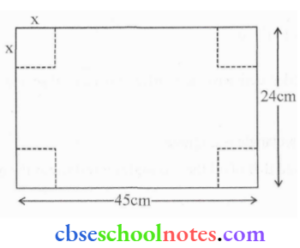
It is not possible to cut off a square of side 18 cm from each corner of the rectangular sheet.
Thus, x cannot be equal to 18.
x \(\neq\) 18
x = 5
Now, V” (5) = 12 (10- 23) = 1 2 (- 1 3) = – 156 < 0
By second order derivative test, x = 5 is the point of maxima.
Question 19. Show that of all the rectangles inscribed in a given fixed circle, the square has the maximum area.
Solution:
Let a rectangle of length l and breadth b be inscribed in the given circle of radius a.
Then, the diagonal passes through the center and is of length 2 cm.
Now. by applying the Pythagoras theorem, we have:
⇒ \((2 a)^2=\ell^2+b^2\)
⇒ \(b^2=4 a^2-c^2 \Rightarrow b=\sqrt{4 a^2-\ell^2}\)

Area of the rectangle, \(\Lambda=\ell \sqrt{4 \mathrm{a}^2-\ell^2} \Rightarrow A^2=\ell^2\left(4 \mathrm{a}^2-\ell^2\right)=\mathrm{B}(\text { let })\)
If A is the maximum B is also maximum
⇒ \(\frac{d B}{d \ell}=8 \mathrm{a}^2 \ell-4 \ell^3 \Rightarrow \frac{d^2 B}{d \ell^2}=8 a^2-12 \ell^2\)
for maxima or minima \(\frac{\mathrm{dB}}{\mathrm{d} \ell}=0 \Rightarrow 8 \mathrm{a}^2 \ell-4 \ell^3=0 \Rightarrow \ell=0\)
or \(\ell=\sqrt{2} \mathrm{a}\)
b=\(\sqrt{4 a^2-2 a^2}=\sqrt{2 a^2}=\sqrt{2 a}\)
Now, when \(\ell=\sqrt{2} \mathrm{a}\)
⇒ \(\frac{d^2 B}{d \ell^2}=8 a^2-12\left(2 a^2\right)=-16 a^2<0\)
By the second order derivative test, when \(\ell=\sqrt{2}\) a, then the area of the rectangle is the maximum.
Since \(\ell=b=\sqrt{2} \mathrm{a}\), the rectangle is a square.
Hence, it has been proved that of all the rectangles inscribed in the given fixed circle, the square has the maximum area.
Question 20. Show that the right circular cylinder of a given surface and maximum volume is such that its height is equal to the diameter of the base.
Solution:
Let r and h be the radius and height of the cylinder respectively.
Then, the surface area (S’) of the cylinder is given by,
⇒ \(\mathrm{S}=2 \pi \mathrm{r}^2+2 \pi \mathrm{h} \Rightarrow \mathrm{h}=\frac{\mathrm{S}-2 \pi \mathrm{r}^2}{2 \pi \mathrm{r}} \Rightarrow \mathrm{h}=\frac{\mathrm{S}}{2 \pi \mathrm{r}}-\mathrm{r}\) → Equation 1
Let V be the volume of the cylinder, Then,
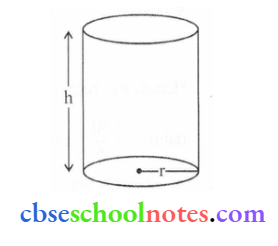
⇒ \(\mathrm{V}=\pi \mathrm{r}^2 \mathrm{~h}=\pi \mathrm{r}^2\left[\frac{\mathrm{S}}{2 \pi}-\mathrm{r}\right]=\frac{\mathrm{Sr}}{2}-\pi \mathrm{r}^3\)
Then, \(\frac{\mathrm{dV}}{\mathrm{dr}}=\frac{\mathrm{S}}{2}-3 \pi \mathrm{r}^2, \frac{\mathrm{d}^2 \mathrm{~V}}{\mathrm{dt}}=-6 \pi \mathrm{rr}\)
for maxima or minima
⇒ \(\frac{d V}{d r}=0 \Rightarrow \frac{S}{2}=3 \pi r^2 \)
⇒ \(r^2=\frac{S}{6 \pi}\)
When \(r^2=\frac{S}{6 \pi}, then \frac{d^2 V}{d r^2}=-6 \pi\left(\sqrt{\frac{S}{6 \pi}}\right)<0\)
By second order derivative test, the volume is the maximum when \(r^2=\frac{S}{6 \pi}\)
Now, when \(r^2=\frac{S}{6 \pi}, or S=6 \pi r^2\) then h=\(\frac{6 \pi r^2}{2 \pi r}-r=3 r-r=2 r\)
Hence, the volume is maximum when the height is twice the radius ie., when the height is equal to the diameter.
Question 21. Of all the closed cylindrical cans (right circular), of a given volume of 100 cubic centimeters. find the dimensions of the can which has the minimum surface area.
Solution:
Let r and h be the radius and height of the cylinder respectively, then the volume (V) of the cylinder is given by,
V =\(\pi r^2 \mathrm{~h}=100\) (given)
h =\(\frac{100}{\pi r^2}\)
The surface area (S) of the cylinder is given by, S =\(2 \pi \mathrm{r}^2+2 \pi \mathrm{h}=2 \pi \mathrm{r}^2+\frac{200}{\mathrm{r}}\)
⇒ \(\frac{\mathrm{dS}}{\mathrm{dr}}=4 \pi \mathrm{r}-\frac{200}{\mathrm{r}^2}, \frac{\mathrm{d}^2 \mathrm{~S}}{\mathrm{dr}^2}=4 \pi+\frac{400}{\mathrm{r}^3}\)
for maxima or minima
⇒ \(\frac{d \mathrm{~S}}{\mathrm{dr}} =0 \Rightarrow 4 \pi r=\frac{200}{\mathrm{r}^2}\)
⇒ \(\mathrm{r}^3=\frac{200}{4 \pi}=\frac{50}{\pi}\)
⇒ \(r^2=\frac{50}{\pi}\)
r=\(\left(\frac{50}{\pi}\right)^{\frac{1}{3}}\)
Now, it is observed that when \(\mathrm{r}=\left(\frac{50}{\pi}\right)^{\frac{1}{3}} \cdot \frac{\mathrm{d}^2 \mathrm{~S}}{\mathrm{dt}^2}>0\)
By second order derivative test, the surface area is the minimum when the radius of the cylinder is
⇒ \(\left(\frac{50}{\pi}\right)^{\frac{1}{3}} \mathrm{~cm}\)
Now, \(\frac{d^2 S}{d r^2}=\frac{400}{r^{\prime}}+4 \pi=8 \pi+4 \pi=12 \pi>0\)
When r=\(\left(\frac{50}{\pi}\right)^{\frac{1}{2}}, \mathrm{~h}=\frac{100}{\pi\left(\frac{50}{\pi}\right)^{\frac{1}{3}}}=\frac{2 \times 50}{(50)^2\left(\frac{1}{\pi}\right)^{\frac{2}{3}} \pi}=2\left(\frac{50}{\pi}\right)^{\frac{1}{3}} \mathrm{~cm}\).
Hence, the required dimensions of the can which has the minimum surface area is given by radius =\(\left(\frac{50}{\pi}\right)^{\frac{1}{3}} \mathrm{~cm}\)
and height =\(2\left(\frac{50}{\pi}\right)^{\frac{3}{3}} \mathrm{~cm}\).
Question 22. A wire of length 28 m is to be cut into two pieces. One of the pieces is to be made into a square and the other into a circle. What should be the length of the two pieces so that the combined area of the square and the circle is minimal?
Solution:
Let a piece of length l be cut from the given wire to make a square.
Then, the other piece of wire to be made into a circle is of length (28- i) m
Now, side of square =\(\frac{t}{4}\).
Let r be the radius of the circle. Then, 2 \(\pi r=28-\ell \Rightarrow r=\frac{1}{2 \pi}(28-\theta)\)
The combined areas of the square and the circle (A) are given by, A= (side of the square) \(^2+\pi \mathrm{se}^{\prime}\)
=\(\frac{\ell^2}{16}+\pi\left[\frac{1}{2 \pi}(28-\ell)\right]^2=\frac{\ell^2}{16}+\frac{1}{4 \pi}(28-)^2 \)
⇒ \(\frac{\mathrm{dA}}{\mathrm{d} \ell}=\frac{2 \ell}{16}+\frac{2}{4 \pi}(28-\ell)(-1)=\frac{\ell}{8}-\frac{1}{2 \pi}(28-\ell)\)
⇒ \(\frac{\mathrm{dA}}{\mathrm{d} \ell}=\frac{\ell}{8}-\frac{1}{2 \pi}(28-\ell) \Rightarrow \frac{\mathrm{d}^2 \mathrm{~A}}{\mathrm{~d} \ell^2}=\frac{1}{8}+\frac{1}{2 \pi}\)
for maxima or minima, \(\frac{\mathrm{dA}}{\mathrm{d} \ell}=0 \Rightarrow \frac{\ell}{8}-\frac{1}{2 \pi}(28-\ell)\)=0
⇒ \(\frac{\pi i-4(28-\theta)}{8 \pi}=0 \Rightarrow(\pi+4(-112=0 \Rightarrow t=\frac{112}{\pi+4}\).
Thus, when \(\ell=\frac{112}{\pi+4}, \frac{d^2 \mathrm{~A}}{\mathrm{~d} \ell^2}>0\)
By second order derivative test, the area (A) is the minimum when \(\ell=\frac{112}{\pi+4}\).
Hence, the combined area is minimum when the length of the wire in making the square is \(\frac{112}{\pi+4}\) m while the length of the wire in making the circle is \(28-\frac{112}{\pi+4}=\frac{28 \pi}{\pi+4} \mathrm{~m}\)
Question 23. Prove that the volume of the largest cone that can be inscribed in a sphere of radius R is \(\frac{8}{27}\) of the volume of the sphere.
Solution:
Let r and h be the radius and height of the cone respectively inscribed in a sphere of radius R.
Let V be the volume of the cone.
Then, V=\(\frac{1}{3} \pi r^2 h\)
The height of the cone is given by,
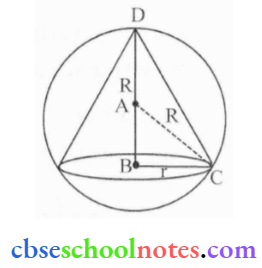
⇒ \(\mathrm{h}-\mathrm{R}+\mathrm{AB}=\mathrm{R}+\sqrt{\mathrm{R}^2-\mathrm{r}^2}\)[ABC is a right triangle]
⇒ \(\mathrm{r}^2=2 \mathrm{hR}-\mathrm{h}^2\)
⇒ \(\mathrm{V}=\frac{1}{3} \pi \mathrm{h}\left(2 \mathrm{hR}-\mathrm{h}^2\right) \Rightarrow \mathrm{V}=\frac{1}{3} \pi\left(2 \mathrm{~h}^2 \mathrm{R}-\mathrm{h}^3\right)\)
⇒ \(\frac{\mathrm{dV}}{\mathrm{dh}}=\frac{1}{3} \pi\left(4 \mathrm{hR}-3 \mathrm{~h}^2\right) and \frac{\mathrm{d}^2 \mathrm{~V}}{\mathrm{dh}^2}=\frac{1}{3} \pi(4 \mathrm{R}-6 \mathrm{~h})\)
for maxima or minima
⇒ \(\frac{\mathrm{dV}}{\mathrm{dh}}=0 \Rightarrow 4 \mathrm{hR}-3 \mathrm{~h}^2=0 \Rightarrow \mathrm{h}=0 or \mathrm{h}=\frac{4 \mathrm{R}}{3}\)
rejecting h =0 , h=\(\frac{4 \mathrm{R}}{3}\)
When h=\(\frac{4 \mathrm{R}}{3}, then \frac{\mathrm{d}^2 \mathrm{~V}}{\mathrm{dh}^2}=\frac{1}{3} \pi(4 \mathrm{R}-8 \mathrm{R})=-\frac{4 \pi \mathrm{R}}{3}<0\)
from (1) \(r^2=2 h R-h^2\)
when h=\(\frac{4 \mathrm{R}}{3}, \mathrm{r}^2=\frac{8 \mathrm{R}^2}{9}\)
By second order derivative test, the volume of the cone is the maximum when \(r^2=\frac{8}{9} R^2\).
Therefore, the volume of a cone
⇒ \(\mathrm{V}=\frac{1}{3} \pi\left(\frac{8}{9} \mathrm{R}^2\right)\left(\frac{4}{3} \mathrm{R}\right)\)
=\(\frac{8}{27}\left(\frac{4}{3} \pi \mathrm{R}^3\right)=\frac{8}{27} \times\) (Volume of the sphere)
Hence, the volume of the largest cone that can be inscribed in the sphere is \(\frac{8}{27}\) the volume of the sphere.
Question 24. The point on the curve \(x^2=2\) y which is nearest to the point (0,5) is?
- \((2 \sqrt{2}, 4)\)
- \((2 \sqrt{2}, 0)\)
- (0,0)
- (2,2)
Solution: 1. \((2 \sqrt{2}, 4)\)
Given curve is \(x^2=2 y\)
Let the point (x, y) on the curve nearest to the point (0,5).
Now distance (D) between (x, y) and (0,5) is
D=\(\sqrt{x^2+(y-5)^2} \Rightarrow D=\sqrt{2 y+(y-5)^2}\)
⇒ \(D^2=2 y+y^2+25-10 y \Rightarrow D^2=y^2-8 y+25\)
Let \(\mathrm{D}^{\mathrm{t}}=\mathrm{z}\)
Then \(z=y^3-8 y+25\)
⇒ \(x^{\prime}=2 y-8\) and \(z^{\prime \prime}=2\)
for maxima or minima
Now, \(z^{\prime}=0 \Rightarrow y=4\)
At \(y=4, x^n=2>0\)
i.e. y=4 is the point of minima.
At y=4, x= \(\pm 2 \sqrt{2}\)
Hence, the required point is ( \(\pm 2 \sqrt{2}, 4\)).
The correct answer is 1.
Question 25. For all real values of x, the minimum value of \(\frac{1-x+x^2}{1+x+x^3}\) is?
- 0
- 1
- 3
- \(\frac{1}{3}\)
Solution: 4.
Let f(x)=\(\frac{1-x+x^2}{1+x+x^2}\)
⇒ \(f^{\prime}(x)=\frac{\left(1+x+x^2\right)(-1+2 x)-\left(1-x+x^2\right)(1+2 x)}{\left(1+x+x^2\right)^2}\)
=\(\frac{-1+2 x-x+2 x^2-x^2+2 x^3-1-2 x+x+2 x^2-x^2-2 x^3}{\left(1+x+x^2\right)^2}\)
=\(\frac{2 x^2-2}{\left(1+x+x^2\right)^2}=\frac{2\left(x^2-1\right)}{\left(1+x+x^2\right)^2}\)
for maxima or minima
f(x)=0 \(\Rightarrow x^2=1 \Rightarrow x= \pm 1\)
Now,f(x)=\(\frac{2\left[\left(1+x+x^2\right)^2(2 x)-\left(x^2-1\right)(2)\left(1+x+x^2\right)(1+2 x)\right]}{\left(1+x+x^2\right)^4}\)
=\(\frac{4\left(1+x+x^2\right)\left[\left(1+x+x^2\right) x-\left(x^2-1\right)(1+2 x)\right]}{\left(1+x+x^2\right)^4}\)
=\(\frac{4\left[x+x^2+x^3-x^3-2 x^3+1+2 x\right]}{\left(1+x+x^2\right)}=\frac{4\left[1+3 x-x^3\right]}{\left(1+x+x^2\right)}\)
And, \(f(1)=\frac{4[1+3-1]}{(1+1+1)^3}=\frac{4(3)}{(3 y}=\frac{4}{9}>0\)
Also, \(f^*(-1)=\frac{4[1-3+1]}{(1-1+1)^2}=4(-1)=-4<0\)
By second order derivative test, f is minimum at x=1 and the minimum value is given by \(f(1)=\frac{1-1+1}{1+1+1}=\frac{1}{3}\),
The correct answer is D.
Question 26. The maximum value of \([x(x-1)+1], 0 \leq x \leq 1\) is ?
- \(\left(\frac{1}{3}\right)^{\frac{1}{1}}\)
- \(\frac{1}{2}\)
- 1
- 0
Solution: 3. 1
Let f(x)=\([x(x-1)+1]^{\frac{1}{2}}\)
⇒ \((\mathrm{x})=\frac{2 \mathrm{x}-1}{3[\mathrm{x}(\mathrm{x}-1)+1]^{\frac{2}{3}}}\)
for maxima or minima
f(x)=0 \(\Rightarrow x=\frac{1}{2}\)
Then, we evaluate the value of f at critical point x=\(\frac{1}{2}\) and at the endpoints of the interval [0,1] {i.e., at x=0 and x=1}.
f(0)=\([0(0-1)+1]^{\frac{1}{j}}=1\)
f(1)=\([1(1-1)+1]^{\frac{1}{5}}=1\)
⇒ \(f\left(\frac{1}{2}\right)=\left[\frac{1}{2}\left(-\frac{1}{2}\right)+1\right]^{\frac{1}{3}}=\left(\frac{3}{4}\right)^{\frac{1}{3}}\)
Hence, we can conclude that the maximum value of f in the interval [0,1] is 1.
The correct answer is 3.
Application Of Derivatives Miscellaneous Exercise
Question 1. Show that the function given by f(x)=\(\frac{\log x}{x}\) has maximum at x=e.
Solution:
The given function is f(x)=\(\frac{\log x}{x}\),
⇒ \(f^{\prime}(x)=\frac{x\left(\frac{1}{x}\right)-\log x}{x^2}=\frac{1-\log x}{x^2}\)
for maxima or minima \(f^{\prime}(x)=0 \Rightarrow \frac{1-\log x}{x^2}=0 \Rightarrow \log x=1 \Rightarrow \log x=\log e \Rightarrow x=c\)
Now, \(f”(x)=\frac{x^2\left(-\frac{1}{x}\right)-(1-\log x)(2 x)}{x^4}=\frac{-x-2 x(1-\log x)}{x^4}\)
= \(\frac{-3+2 \log x}{x^3} at x=e, f^{\prime}(e)=\frac{-3+2 \log e}{e^3}=\frac{-3+2}{e^3}=\frac{-1}{e^3}<0\)
Therefore, by second order derivative test, f(x) is maximum at x=e.
Question 2. The two equal sides of an isosceles triangle with fixed base b are decreasing at the rate of 3 cm per second. How fast is the area decreasing when the two equal sides are equal to the base ?
Solution:
Let \(\triangle\) A B C be isosceles where BC is the base of fixed length b.
Let the length of the two equal sides of \triangle \(\mathrm{ABC}\) be a.
Draw AD \(\perp\) BC

Now, in \(\triangle\) A D C, by applying the Pythagoras theorem,
we have: A D=\(\sqrt{a^2-\frac{b^2}{4}}\)
Area of triangle A B C is A=\(\frac{1}{2} B C \cdot A D=\frac{b}{2} \sqrt{a^2-\frac{b^3}{4}}\)
The rate of change of the area with respect to time (t) is given by,
⇒ \(\frac{d A}{d t}=\frac{1}{2} b \cdot \frac{2 a}{2 \sqrt{a^2-\frac{b^2}{4}}} \frac{d a}{d t}=\frac{a b}{\sqrt{4 a^2-b^2}} \frac{d a}{d t}\)
It is given that the two equal sides of the triangle are decreasing at the rate of 3 cm per second.
⇒ \(\frac{\mathrm{da}}{\mathrm{dt}}=-3 \mathrm{~cm} / \mathrm{s}\)
⇒ \(\frac{\mathrm{dA}}{\mathrm{dt}}=\frac{-3 \mathrm{ab}}{\sqrt{4 \mathrm{a}^2-\mathrm{b}^2}}\)
Then, when a=b, we have: \(\frac{d A}{d t}=\frac{-3 b^2}{\sqrt{4 b^2-b^2}}=\frac{-3 b^2}{\sqrt{3 b^2}}=-\sqrt{3} \mathrm{~cm}^2 / \mathrm{s}\)
Hence, if the two equal sides are equal to the base, then the area of the triangle is decreasing at the rate of \(\sqrt{3} \mathrm{~b} \mathrm{~cm}^2 / \mathrm{s}\).
Question 3. Find the intervals in which the function f is given by \(f(\mathrm{x})=\frac{4 \sin \mathrm{x}-2 \mathrm{x}-\mathrm{x} \cos \mathrm{x}}{2+\cos \mathrm{x}}\) is
- increasing
- decreasing
Solution:
f(x) =\(\frac{4 \sin x-2 x-x \cos x}{2+\cos x}\)
⇒ \(f^{\prime}(x)=\frac{(2+\cos x)(4 \cos x-2-\cos x+x \sin x)-(4 \sin x-2 x-x \cos x)(-\sin x)}{(2+\cos x)^2}\)
=\(\frac{(2+\cos x)(3 \cos x-2+x \sin x)+\sin x(4 \sin x-2 x-x \cos x)}{(2+\cos x)^2}\)
=\(\frac{6 \cos x-4+2 x \sin x+3 \cos ^2 x-2 \cos x+x \sin x \cos x+4 \sin ^2 x-2 x \sin x-x \sin x \cos x}{(2+\cos x)^2}\)
=\(\frac{4 \cos x-4+3 \cos ^2 x+4 \sin ^2 x}{(2+\cos x)^2}=\frac{4 \cos x-4+3 \cos ^2 x+4-4 \cos ^2 x}{\left(2+\cos ^2 x\right)^2-}\)
=\(\frac{4 \cos x-\cos ^2 x}{(2+\cos x)^2}=\frac{\cos x(4-\cos x)}{(2+\cos x)^2}\)
Now, x=\(\frac{\pi}{2}\) and x=\(\frac{3 \pi}{2}\) divides [0,2 \(\pi\)] into three intervals i.e. \(\left[0, \frac{\pi}{2}\right],\left[\frac{\pi}{2}, \frac{3 \pi}{2}\right]\) and \(\left[\frac{3 \pi}{2}, 2 \pi\right]\).
In intervals \(\left[0, \frac{\pi}{2}\right]\) and \(\left[\frac{3 \pi}{2}, 2 \pi\right], \mathrm{f}^{\prime}(\mathrm{x})>0\)
Thus, f(x) is increasing for \(\left[0, \frac{\pi}{2}\right]\) and \(\left[\frac{3 \pi}{2}, 2 \pi\right]\)
In the interval \(\left[\frac{\pi}{2}, \frac{3 \pi}{2}\right], \mathrm{f}^{\prime}(\mathrm{x}) \leq 0\).
Thus, \(\mathrm{f}(\mathrm{x})\) is decreasing for \(\left[\frac{\pi}{2}, \frac{3 \pi}{2}\right]\).
Question 4. Find the intervals in which the function f given by \(f(\mathrm{x})=\mathrm{x}^3+\frac{1}{\mathrm{x}^3}, \mathrm{x} \neq\) 0 is
- increasing
- decreasing
Solution:
⇒ \(f(\mathrm{x})=\mathrm{x}^3+\frac{1}{\mathrm{x}^3}\)
⇒ \(f^{\prime}(\mathrm{x})=3 \mathrm{x}^2-\frac{3}{\mathrm{x}^4}=\frac{3 \mathrm{x}^6-3}{\mathrm{x}^4}\)
Then, \(f^{\prime}(x)=0 \Rightarrow 3 x^6-3=0 \Rightarrow x^6=1 \Rightarrow x= \pm 1\)
Now, the points x=1 and x=-1 divide the real line into three intervals i.e., \((-\infty,-1],[-1,1]\) and \([1, \infty)\).
In intervals \((-\infty,-1] and [1, \infty) f^{\prime}(x) \geq 0\)
⇒ f(x) is increasing in \((-\infty,-1] \cup[1, \infty)\)
In interval [-1,1] \(\mathrm{f}^{\prime}(\mathrm{x})<0\).
f(x) is decreasing in [-1,1]
Question 5. Find the maximum area of an isosceles triangle inscribed in the ellipse \(\frac{x^2}{a^2}+\frac{y^2}{b^2}\)=1 with its vertex at one end of the major axis.
Solution:
The given ellipse is \(\frac{x^2}{a^2}+\frac{y^2}{b^2}\)=1, Its paranctric form is x=a \(\cos \theta, y=b \sin \theta\)
Let the major axis be along the x-axis.
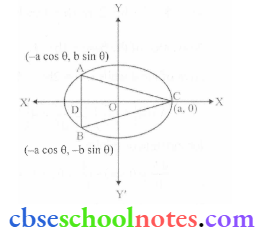
Let ABC be the triangle inscribed in the ellipse where vertex C is at (a, 0)
Since the ellipse is symmetrical with respect to the x-axis and y-axis, we can assume the coordinates of A to be \((-\mathrm{a} \cos \theta, \mathrm{b} \sin \theta)\) and the coordinates of B to be \((-\mathrm{a} \cos \theta,-\mathrm{b} \sin \theta )\)
⇒ \(\mathrm{AB}=2 \mathrm{~b} \sin \theta\) and \(\mathrm{DC}=(\mathrm{a}+\mathrm{a} \cos \theta)\)
the area of triangle ABC is given by,
A=\(\frac{1}{2} A B \cdot D C \Rightarrow A=\frac{1}{2}(2 b \sin \theta) \cdot(a+a \cos \theta)\)
A=a b \(\sin \theta(1+\cos \theta)\)
⇒ \(\mathrm{AB}=2 \mathrm{bsin} \theta\) and \(\mathrm{DC}=(\mathrm{a}+\mathrm{a} \cos \theta)\)
the area of triangle A B C is given by,
A=\(\frac{1}{2} A B \cdot D C \Rightarrow A=\frac{1}{2}(2 b \sin \theta) \cdot(a+a \cos \theta)\)
A=a b \(\sin \theta(1+\cos \theta)\)
⇒ \(\frac{d A}{d \theta}=a b[\sin \theta(-\sin \theta)+(1+\cos \theta) \cos \theta] \Rightarrow \frac{d A}{d \theta}\)
=a b\(\left[\cos \theta+\cos ^2 \theta-\sin ^2 \theta\right]\)
and \(\frac{d^2 A}{d \theta^2}=a b[-\sin \theta-2 \sin \theta \cos \theta-2 \sin \theta \cos \theta] \Rightarrow \frac{d^2 A}{d \theta^2}=-a b[\sin \theta+4 \sin \theta \cos \theta]\)
for maxima or minima \(\frac{\mathrm{dA}}{\mathrm{d} \theta}\)=0
a b\(\left[\cos \theta+\cos ^2 \theta-\sin ^2 \theta\right]=0 \Rightarrow \cos \theta+\cos ^2 \theta-1+\cos ^2 \theta=0 \)
⇒ \(2 \cos ^2 \theta+\cos \theta-1=0 \Rightarrow \cos \theta=-1 or \cos \theta=\frac{1}{2}\)
⇒ ⇒ \(\theta=\pi or \theta=\frac{\pi}{3}\)
rejecting \(\theta=\pi\)
\(\theta=\frac{\pi}{3}\)Now at \(\theta=\frac{\pi}{3}, \frac{d^2 A}{d \theta^2}=-a b\left[\sin \frac{\pi}{3}+4 \sin \frac{\pi}{3} \cos \frac{\pi}{3}\right]\)
= \(-a b\left[\frac{\sqrt{3}}{2}+4 \cdot \frac{\sqrt{3}}{2} \cdot \frac{1}{2}\right]<0\)
By the second derivative test, the Area (A) of an isosceles triangle is maximum when \(\theta=\frac{\pi}{3}\)
The maximum area of the triangle is given by,
⇒ \(\left.A=a b \sin \theta(1+\cos \theta)=a b \sin \frac{\pi}{3}\left(1+\cos \frac{\pi}{3}\right)-a b \cdot \frac{\sqrt{3}}{2} / 1+\frac{1}{2}\right)\)
=\(\frac{3 \sqrt{3}}{4} a b \cdot s q \cdot\) units
Question 6. A tank with a rectangular base and rectangular sides, open at the top is to be constructed so that its deÿtdis lava volume is 8 ark If the buildup of the tank costs Rs 70 per square meter for the base and Rs 45 per square meter for the sides, What is the cost of least expensive tank?
Solution:
Let l, b, and h represent the length, breadth, and height of the tank respectively.
Then, we have height (h) = 2 m
Volume of the tank. = 8m³ ; Volume of the tank =L x b x h
Now, the area of the base = lb = 4
Area of the 4 walls (A) = 2h(l + b)
A =4\(\left(\ell+\frac{4}{\ell}\right) \Rightarrow \frac{\mathrm{dA}}{\mathrm{d} \ell}=4\left(1-\frac{4}{\ell^2}\right)\)
for maxima or minima
⇒ \(\frac{\mathrm{dA}}{\mathrm{d} \ell}=0 \Rightarrow 1-\frac{4}{\ell^2}=0 \Rightarrow \ell^2=4 \Rightarrow \ell= \pm 2\)
However, the length cannot be negative. Therefore, we have \(\ell\)=2
b=\(\frac{4}{\ell}=\frac{4}{2}\)=2
Now, \(\frac{\mathrm{d}^2 \mathrm{~A}}{\mathrm{~d} \ell^2}=\frac{32}{\ell^3}\)
When \(\ell=2, \frac{\mathrm{d}^2 \mathrm{~A}}{\mathrm{~d} \ell^2}=\frac{32}{8}=4>0\).
Thus, by second order derivative test, the area is the minimum when \(\ell\)=2.
We have t=\(\mathrm{b}=\mathrm{h}\)=2.
Cost of building the base = Rs 70 \(\times(\ell b)\)= Rs 70(4)= Rs 280
Cost of building the walls = Rs 2 h\((\ell+\mathrm{b}) \times 45\)= Rs 90(2)(2+2)= Rs 720
Required total cost =Rs(280+720)= Rs 1000
Hence, the total cost of the tank will be Rs 1000.
Question 7. The sum of the perimeter of a circle and square is k, where k is some constant. Prove that the sum of their areas is least when the side of the square is double the radius of the circle.
Solution:
Let ‘r’ be the radius of the circle and ‘a’ be the side of the square.
Then, we have :
2 \(\pi r+4 a=k\) (where k is constant)
a=\(\frac{\mathrm{k}-2 \pi \mathrm{r}}{4}\)
The sum of the areas of the circle and the square (A) is given by,
A =\(\pi \mathrm{r}^2+\mathrm{a}^2=\pi\)
⇒ \(\mathrm{r}^2+\frac{(\mathrm{k}-2 \pi \mathrm{r})^2}{16}\)
⇒ \(\frac{\mathrm{dA}}{\mathrm{dr}}=2 \pi \mathrm{r}+\frac{2(\mathrm{k}-2 \pi \mathrm{r})(-2 \pi)}{16}=2 \pi \mathrm{r}-\frac{\pi(\mathrm{k}-2 \pi \mathrm{r})}{4}\)
for maxima or minima
⇒ \(\frac{\mathrm{dA}}{\mathrm{dr}}\) =0
2 \(\pi \mathrm{r} =\frac{\pi(\mathrm{k}-2 \pi \mathrm{r})}{4}\)
8 \(\mathrm{r}=\mathrm{k}-2 \pi \mathrm{r} \Rightarrow(8+2 \pi) \mathrm{r}=\mathrm{k} \Rightarrow \mathrm{r}=\frac{\mathrm{k}}{8+2 \pi}=\frac{\mathrm{k}}{2(4+\pi)}\)
Now, \(\frac{\mathrm{d}^2 \mathrm{~A}}{\mathrm{dr}^2}=2 \pi+\frac{\pi^2}{2}\)
When r=\(\frac{k}{2(4+\pi)}, \frac{d^2 A}{d r^2}>0\).
The sum of the areas is least when r =\(\frac{\mathrm{k}}{2(4+\pi)}\).
When r=\(\frac{k}{2(4+\pi)}, a=\frac{k-2 \pi\left[\frac{k}{2(4+\pi)}\right]}{4}=\frac{k-\frac{\pi k}{(4+\pi)}}{4}=\frac{4 k+\pi k-\pi k}{4(4+\pi)}=\frac{k}{4+\pi}=2 r\)
Hence, it has been proved that the sum of their areas is least when the side of the square is Double the radius of the circle.
Question 8. A window is in the form of a rectangle surmounted by a semicircular opening. The total perimeter of the window is 10 m. Find the dimensions of the window to admit maximum light through the whole opening.
Solution:
Let 2x and y be the length and breadth of the rectangular window respectively.
The radius of the semicircular opening = x
It is given that the perimeter of the window is 10 m.
⇒ \(2 x+2 y+\pi x=10 \Rightarrow y=5-x-\frac{\pi x}{2}\)
Now, the Area of the window is given by.

A =2 \(\mathrm{xy}+\frac{\pi \mathrm{x}^2}{2} \Rightarrow \mathrm{A}=2 \mathrm{x}\left(5-\mathrm{x}-\frac{\pi \mathrm{x}}{2}\right)+\frac{\pi \mathrm{x}^2}{2}\)
⇒ \(\mathrm{A}=10 \mathrm{x}-2 \mathrm{x}^2-\pi \mathrm{x}^2+\frac{\pi \mathrm{x}^2}{2} \Rightarrow \mathrm{A}=10 \mathrm{x}-2 \mathrm{x}^2-\frac{\pi \mathrm{x}^2}{2}\)
⇒ \(\frac{\mathrm{dA}}{\mathrm{dx}}=10-4 \mathrm{x}-\pi \mathrm{x} \frac{\mathrm{d}^2 \mathrm{~A}} {\mathrm{dx}^2}=-4-\pi\)
for maxima or minima
⇒ \(\frac{\mathrm{dA}}{\mathrm{dx}}=0 \Rightarrow 10-4 \mathrm{x}-\pi \mathrm{x}=0 \Rightarrow \mathrm{x}=\frac{10}{\pi+4}\)
Thus, when x=\(\frac{10}{\pi+4}, then \frac{d^2 A}{d x^2}<0\).
Therefore, by second-order derivative test, the area is the maximum when length 2 x=\(\frac{20}{\pi+4} m \)
Now,y=5-\(\frac{10}{\pi+4}-\frac{\pi}{2}\left(\frac{10}{\pi+4}\right) \Rightarrow y=\frac{10}{\pi+4}\)
Hence, the required dimensions of the window to admit maximum light is given by length =\(\frac{20}{\pi+4}\) m and breadth =\(\frac{10}{\pi+4}\) m.
Question 9. A point on the hypotenuse of a triangle is at distance ‘ a ‘ and ‘ b ‘ from the sides of the triangle.
Show that the minimum length of the hypotenuse is \(\left(a^{\frac{2}{3}}+b^{\frac{2}{3}}\right)^{\frac{2}{2}}\)
Solution:
Let \(\triangle\) A B C be right-angled at B. Let A B=x and B C=y.
Let P be a point on the hypotenuse of the triangle such that P is at a distance of a and b from the sides AB and BC respectively.
Let \(\angle \mathrm{C}=\theta\).
We have, A C=\(\sqrt{x^2+y^2}\)
Now, P C=b \({cosec} \theta\) and, \(A P=a \sec \theta\)
AC=A P+P C
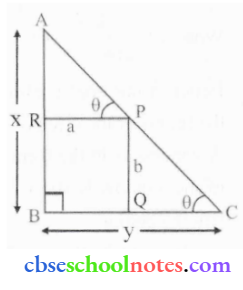
AC=b {cosec} \(\theta+a \sec \theta\)
⇒ \(\frac{d(A-C)}{d \theta}=-b {cosec} \theta \cot \theta+a \sec \theta \tan \theta\)
⇒ \(\frac{d(A-C)}{d \theta}=-b {cosec} \theta \cot \theta+a \sec \theta \tan \theta\)
and \(\frac{d^2(A-C)}{d \theta^2}=b\left({cosec} \theta \cot ^2 \theta+{cosec}^3 \theta\right)+a\left(\sec ^3 \theta+\sec \theta \tan ^2 \theta\right)\)
for maxima or minima
⇒ \(\frac{\mathrm{d}(\mathrm{AC})}{\mathrm{d} \theta}=0 \Rightarrow \mathrm{asec} \theta \tan \theta=b {cosec} \theta \cot \theta\)
⇒ \(\frac{\mathrm{a}}{\cos \theta} \cdot \frac{\sin \theta}{\cos \theta}=\frac{\mathrm{b}}{\sin \theta} \frac{\cos \theta}{\sin \theta}\)
⇒ \({asin}^3 \theta=b \cos ^3 \theta \Rightarrow(\mathrm{a})^{\frac{1}{3}} \sin \theta=(b)^{\frac{1}{3}} \cos \theta \Rightarrow \tan \theta=\left(\frac{b}{a}\right)^{\frac{1}{3}}\)
⇒ \(\sin \theta =\frac{(b)^{\frac{1}{3}}}{\sqrt{a^{\frac{2}{3}}+b^{\frac{2}{3}}}} \text { and } \cos \theta=\frac{(\mathrm{a})^{\frac{1}{3}}}{\sqrt{a^{\frac{2}{3}}+b^{\frac{2}{3}}}}\)
Since, \(0<\theta<\frac{\pi}{2}\), so trigonometric ratios are positive.
Also, a>0 and b>0 \(\frac{d^2(A C)}{d \theta^2}\) is positive.
It can be clearly shown that \(\frac{\mathrm{d}^2(\mathrm{AC})}{\mathrm{d} \theta^2}>0\) when\(\tan \theta=\left(\frac{\mathrm{b}}{\mathrm{a}}\right)^{\frac{1}{3}}\)
Therefore, by second order derivative test, the length of the hypotenuse is minimum when
⇒ \(\tan \theta=\left(\frac{b}{a}\right)^{\frac{1}{3}}\) .
Now, when \(\tan \theta=\left(\frac{b}{a}\right)^{\frac{1}{3}}\),
we have : A C=\(\frac{b \sqrt{a^{\frac{2}{3}}+b^{\frac{2}{3}}}}{b^{\frac{1}{3}}}+\frac{a \sqrt{a^{\frac{2}{3}}+b^{\frac{2}{3}}}}{a^{\frac{1}{3}}}\)
=\(\sqrt{a^{\frac{2}{3}}+b^{\frac{2}{3}}\left(b^{\frac{2}{3}}+a^{\frac{2}{3}}\right)=\left(a^{\frac{2}{3}}+b^{\frac{2}{3}}\right)^{\frac{1}{2}}} [Using (1) and (2)]\)
Hence, the minimum length of the hypotenuse is \(\left(a^{\frac{2}{3}}+b^{\frac{2}{3}}\right)^{\frac{3}{2}}.\)
Question 10. Find the points at which the function f given by \(f(x)=(x-2)^4(x+1)^3\) has
- local maxima
- local minima
- point of inflection
Solution:
The given function is f(x)=\((x-2)^4(x+1)^3\).
⇒ \(f^{\prime}(x) =4(x-2)^3(x+1)^3+3(x+1)^2(x-2)^4\)
=\((x-2)^5(x+1)^2[4(x+1)+3(x-2)]=(x-2)^3(x+1)^2(7 x-2)\)
For maxima or minima
⇒ \(\mathrm{f}(\mathrm{x})=0 \Rightarrow(\mathrm{x}-2)^3(\mathrm{x}+1)^2(7 \mathrm{x}-2)\)=0
⇒ \(f^{\prime}(x)=0 \Rightarrow x=-1 and x=\frac{2}{7} or x=2\)
Now, for values of x close to \(\frac{2}{7}\) and to the left of \(\frac{2}{7}, f^{\prime}(x)>0\).
Also, for values of x close to \(\frac{2}{7}\) and to the right of \(\frac{2}{7}, \mathrm{f}^{\prime}(\mathrm{x})<0\).
Thus, x=\(\frac{2}{7}\) is the point of local maxima.
Now, for values of x close to 2 and to the left of 2, \(f^{\prime}(x)<0\). Also, for values of x close to 2 and to the right of 2, \(f^{\prime}(\mathrm{x})>0\)
Thus, x=2 is the point of local minima.
Now, as the value of x varies through -1, \(f^{\prime}(x)\) does not change its sign.
Thus, x=-1 is the point of inflection.
Question 11. Find the absolute maximum and minimum values of the function f given by
Solution:
f(x)=\(\cos ^2 x+\sin x, x \in[0, \pi]\)
f(x)=\(\cos ^2 x+\sin x\)
⇒ \(f^{\prime}(x)=2 \cos x(-\sin x)+\cos x=-2 \sin x \cos x+\cos x\)
Now, \(\mathrm{f}^{\prime}(\mathrm{x})\)=0
2 \(\sin x \cos x=\cos x\)
⇒ \(\cos x(2 \sin x-1)=0 \Rightarrow \sin x=\frac{1}{2}\)
or \(\cos x=0 \Rightarrow x=\frac{\pi}{6}\) or \(\frac{\pi}{2}\) as x \(\in[0, \pi]\)
Now, evaluating the value of f at critical points x=\(\frac{\pi}{2}\) and x=\(\frac{\pi}{6}\) and the endpoints of the interval [0, \(\pi\)] (i.e., at x=0 and \(x=\pi\) ), we have:
⇒ \(f\left(\frac{\pi}{6}\right)=\cos ^2 \frac{\pi}{6}+\sin \frac{\pi}{6}=\left(\frac{\sqrt{3}}{2}\right)^2+\frac{1}{2}=\frac{5}{4}\)
⇒ \(\mathrm{f}(0)=\cos ^2 0+\sin 0=1+0=1\)
⇒ \(\mathrm{f}(\pi)=\cos ^2 \pi+\sin \pi-(-1)^3+0=1\)
⇒ \(\mathrm{f}\left(\frac{\pi}{2}\right)=\cos ^2 \frac{\pi}{2}+\sin \frac{\pi}{2}=0+1=1\)
Hence, the absolute maximum value of f is \(\frac{5}{4} \)occurring at x =\(\frac{\pi}{6}\) and the absolute minimum value of f is 1 occurring at x=0, \(\frac{\pi}{2}\)/ and \(\pi\).
Question 12. Show that the altitude of the right circular cone of maximum volume that can be inscribed in a sphere or radius r is \(\frac{4 r}{3}\).
Solution:
A sphere of fixed radius (r) is given.
Let R and h be the radius and the height of the cone respectively,
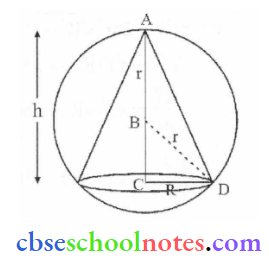
The volume \((\mathrm{V})\) of the cone is given by,V =\(\frac{1}{3} \pi \mathrm{R}^2 \mathrm{~h}\)
In \(\triangle\) B C D, B C=\(\sqrt{r^2-R^2}\)
⇒ \(\mathrm{h}=\mathrm{r}+\sqrt{\mathrm{r}^2-\mathrm{R}^2} \Rightarrow \mathrm{R}^2=2 h r-\mathrm{h}^2\)
⇒ \(\mathrm{V}=\frac{1}{3} \pi h\left(2 h r-h^2\right)=\frac{1}{3} \pi\left(2 \mathrm{~h}^2 \mathrm{r}-\mathrm{h}^3\right)\)
⇒ \(\frac{\mathrm{dV}}{\mathrm{dh}}=\frac{1}{3} \pi\left(4 \mathrm{hr}-3 \mathrm{~h}^2\right) and \frac{\mathrm{d}^2 \mathrm{~V}}{\mathrm{dh}^2}=\frac{1}{3} \pi(4 \mathrm{r}-6 \mathrm{~h})\)
for maxima or minima
⇒ \(\frac{\mathrm{dV}}{\mathrm{dh}}=0 \Rightarrow 4 \mathrm{hr}-3 \mathrm{~h}^2=0 \Rightarrow \mathrm{h}=0 or \mathrm{h}=\frac{4 \mathrm{r}}{3}\)
rejecting h 0 \(\mathrm{h}=\frac{4 \mathrm{r}}{3}\)
when h =\(\frac{4 \mathrm{r}}{3}, \frac{\mathrm{d}^2 \mathrm{~V}}{\mathrm{dh}^2}=\frac{1}{3} \pi(4 \mathrm{r}-8 \mathrm{r})=-\frac{4 \mathrm{r} \pi}{3}<0\)
V is maximum when \(h=\frac{4 \mathrm{r}}{3}\)
By second order derivative test, the volume of the cone is maximum when the altitude of the cone is \(\frac{4 \mathrm{r}}{3}\)
Question 13. Let f be a function defined on [a, b] such that \(f^{\prime}(x)>0\), for all x \(\in\)(a, b), then prove that f is an increasing function on (a, b).
Solution:
Since, \(f^{\prime}(x)>0\) on (a, b)
Then, f is a differentiable function on (a, b)
Also, every differentiable function is continuous,
Therefore, f is continuous on [a, b]
Let \(x_1, x_2 \in(a, b)\) such that, \(x_2>x_1\) then by LMV theorem, there exists c \(\in(a, b)\) s.t.
⇒ \(f^{\prime}(c)=\frac{f\left(x_2\right)-f\left(x_1\right)}{x_2-x_1}\)
⇒ \(f\left(x_2\right)-f\left(x_1\right)=\left(x_2-x_1\right) f^{\prime}(c)\)
⇒ \(f\left(x_2\right)-f\left(x_1\right)>0 \text { as } x_2>x_1 \text { and } f^{\prime}(x)>0\)
⇒ \(f\left(x_1\right)>f\left(x_1\right)\)
for \(\mathrm{x}_1<\mathrm{x}_2 \Rightarrow \mathrm{f}\left(\mathrm{x}_1\right)<\mathrm{f}\left(\mathrm{x}_2\right)\).
Therefore, f is an increasing function.
Question 14. A cylindrical tank of radius 10 m is being filled with wheat at the rate of 314 cubic meters per hour. Then the depth of the wheat is increasing at the rate of?
- 1 \(\mathrm{~m} / \mathrm{h}\)
- 0.1 \(\mathrm{~m} / \mathrm{h}\)
- 1.1 \(\mathrm{~m} / \mathrm{h}\)
- 0.5 \(\mathrm{~m} / \mathrm{h}\)
Solution: 1. 1\(\mathrm{~m} / \mathrm{h}\)
Let r be the radius of the cylinder
Then, volume \((\mathrm{V})\) of the cylinder is given by =\(\pi r^t \mathrm{~h}\),
V =\(\pi(\text { radius })^2 \times \text { height }\)
⇒ \(\left.=\pi(10)^2 \mathrm{~h} \quad \quad \text { (radius }=10 \mathrm{~m}\right)\)
=100 \(\pi \mathrm{h}\)
Differentiating with respect to time t, we have :
⇒ \(\frac{\mathrm{dV}}{\mathrm{dt}}=100 \pi \frac{\mathrm{dh}}{\mathrm{dt}}\)
The tank is being filled with wheat at the rate of 314 cubic meters per hour.
⇒ \(\frac{\mathrm{dV}}{\mathrm{dt}}=314 \mathrm{~m}^3 / \mathrm{h}\)
Thus, we have :
314=100 \(\pi \frac{\mathrm{dh}}{\mathrm{dt}} \Rightarrow \frac{\mathrm{dh}}{\mathrm{dt}}=\frac{314}{100(3.14)}=\frac{314}{314}=1\)
Hence, the depth of wheat is increasing at the rate of 1 \(\mathrm{~m} / \mathrm{h}\).
The correct answer is 1.
